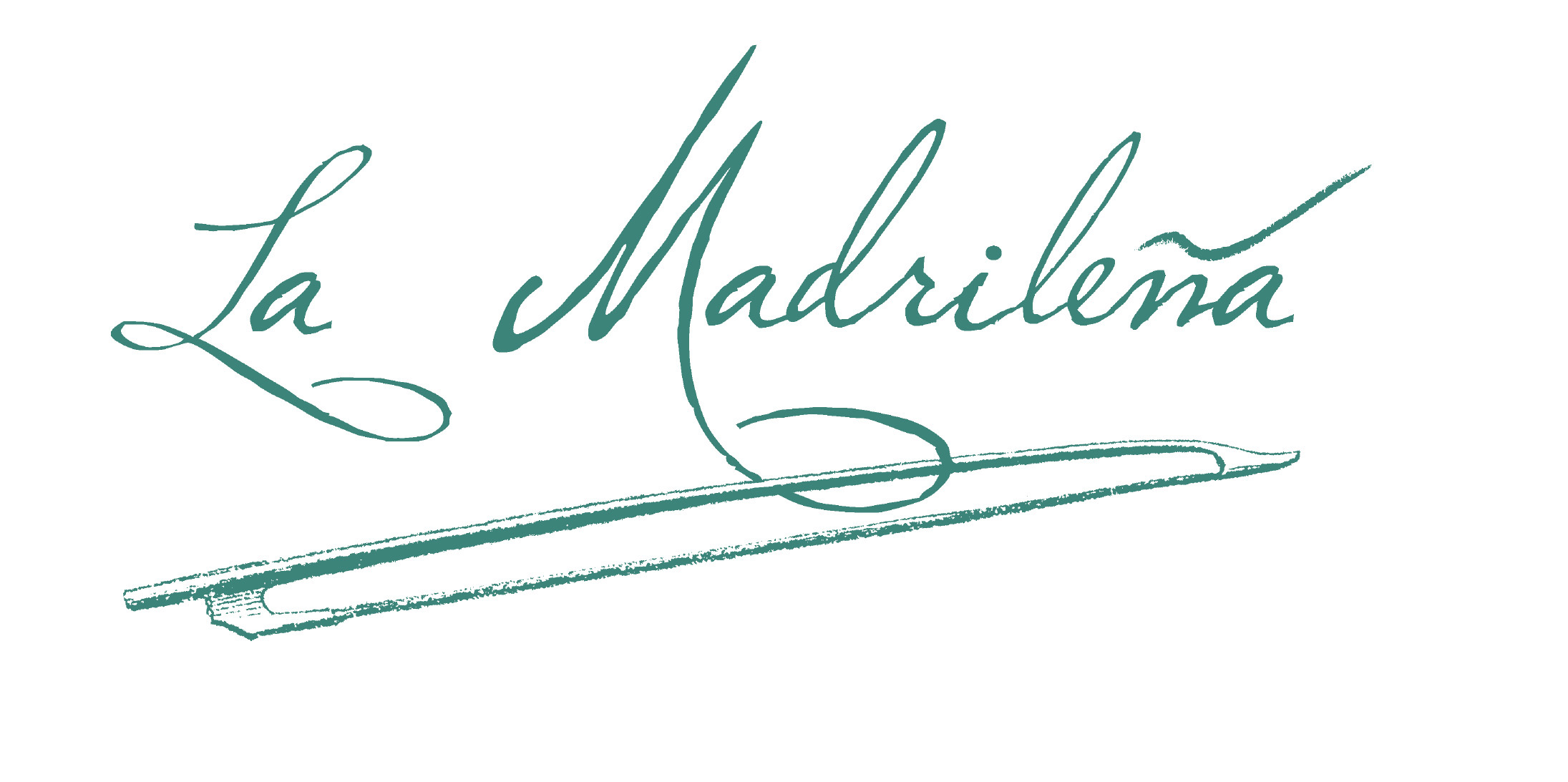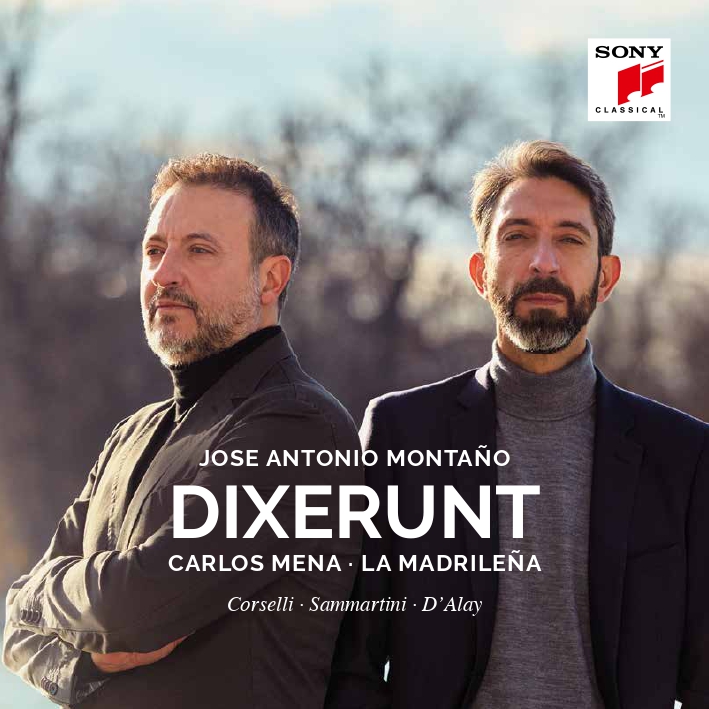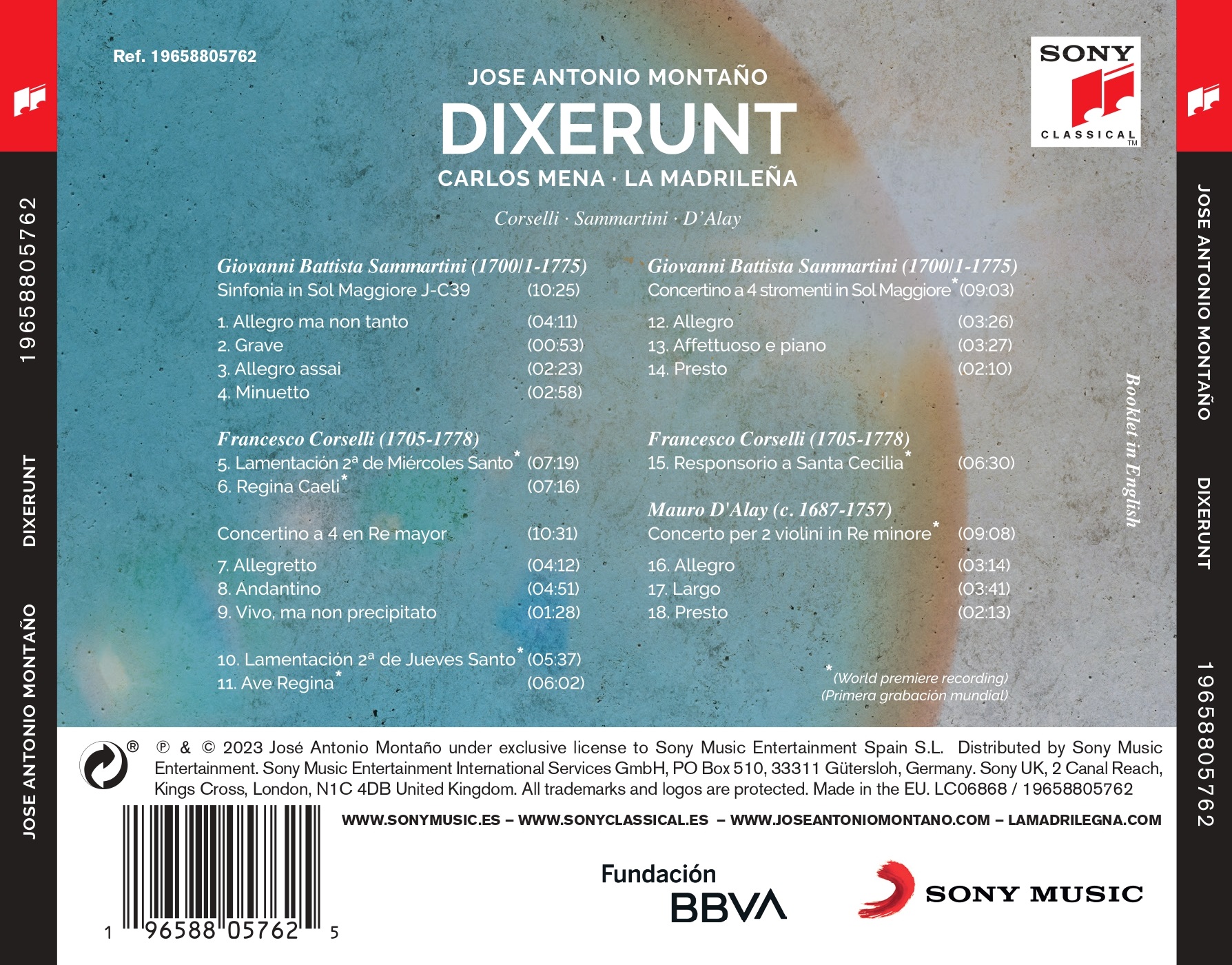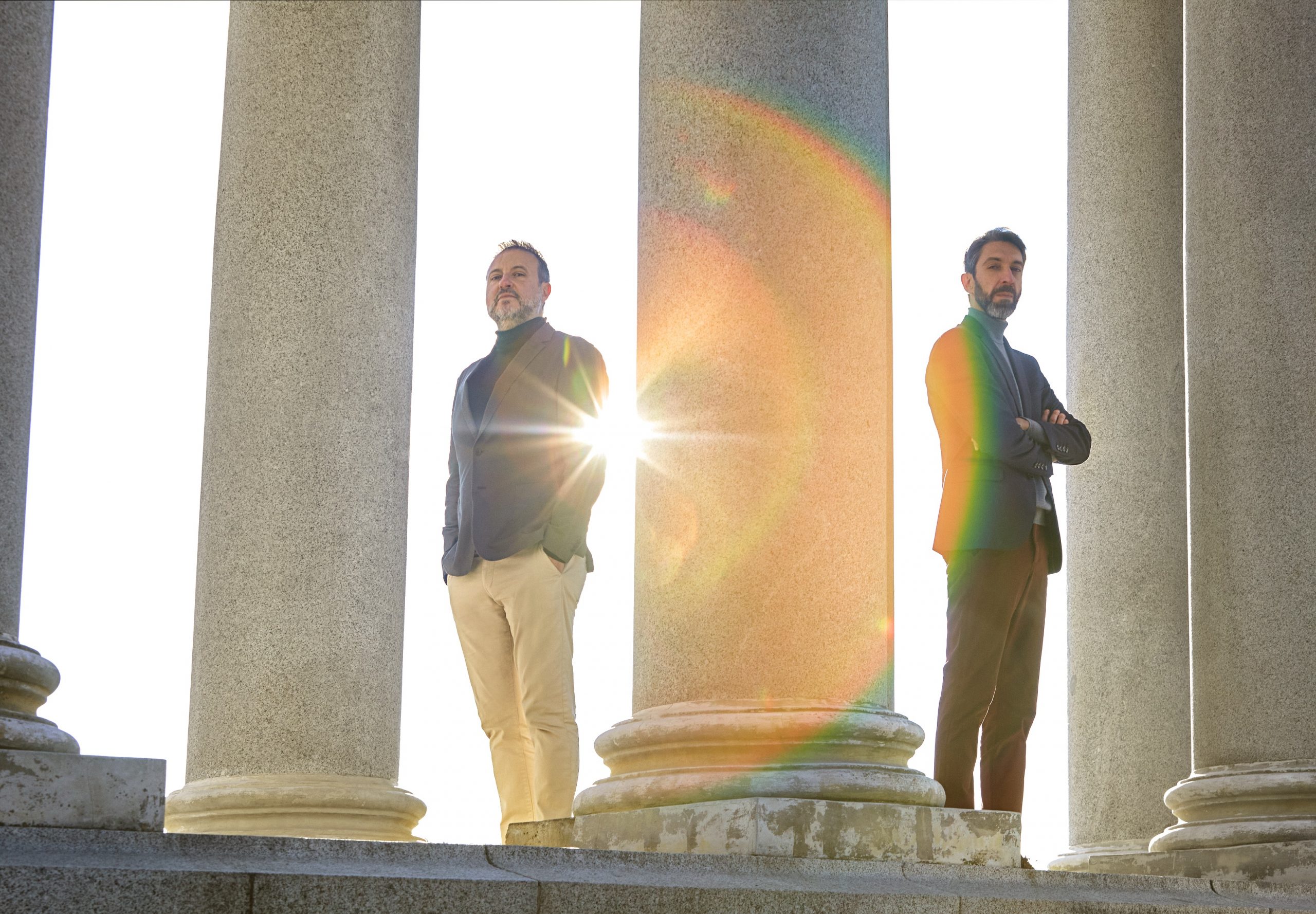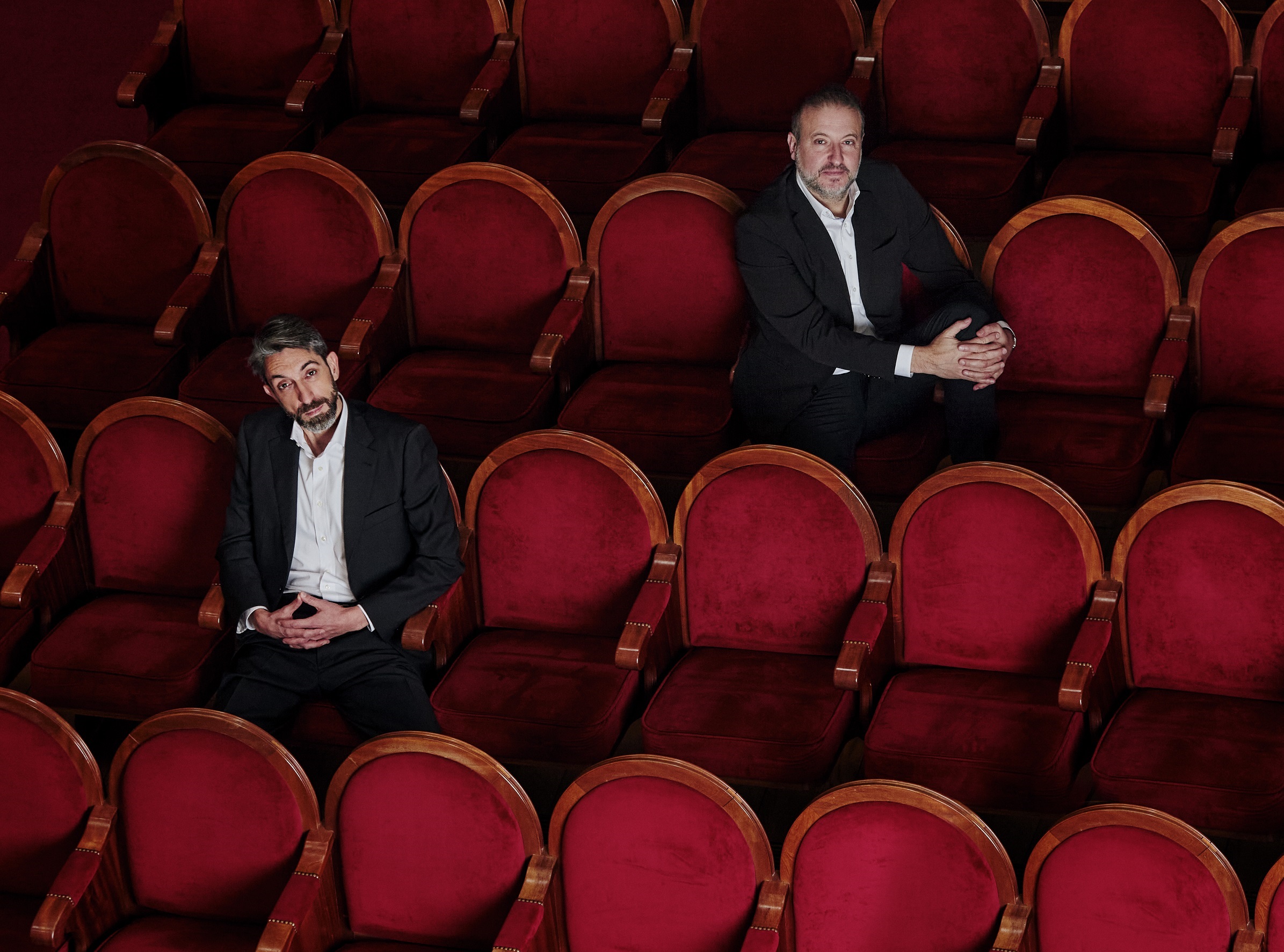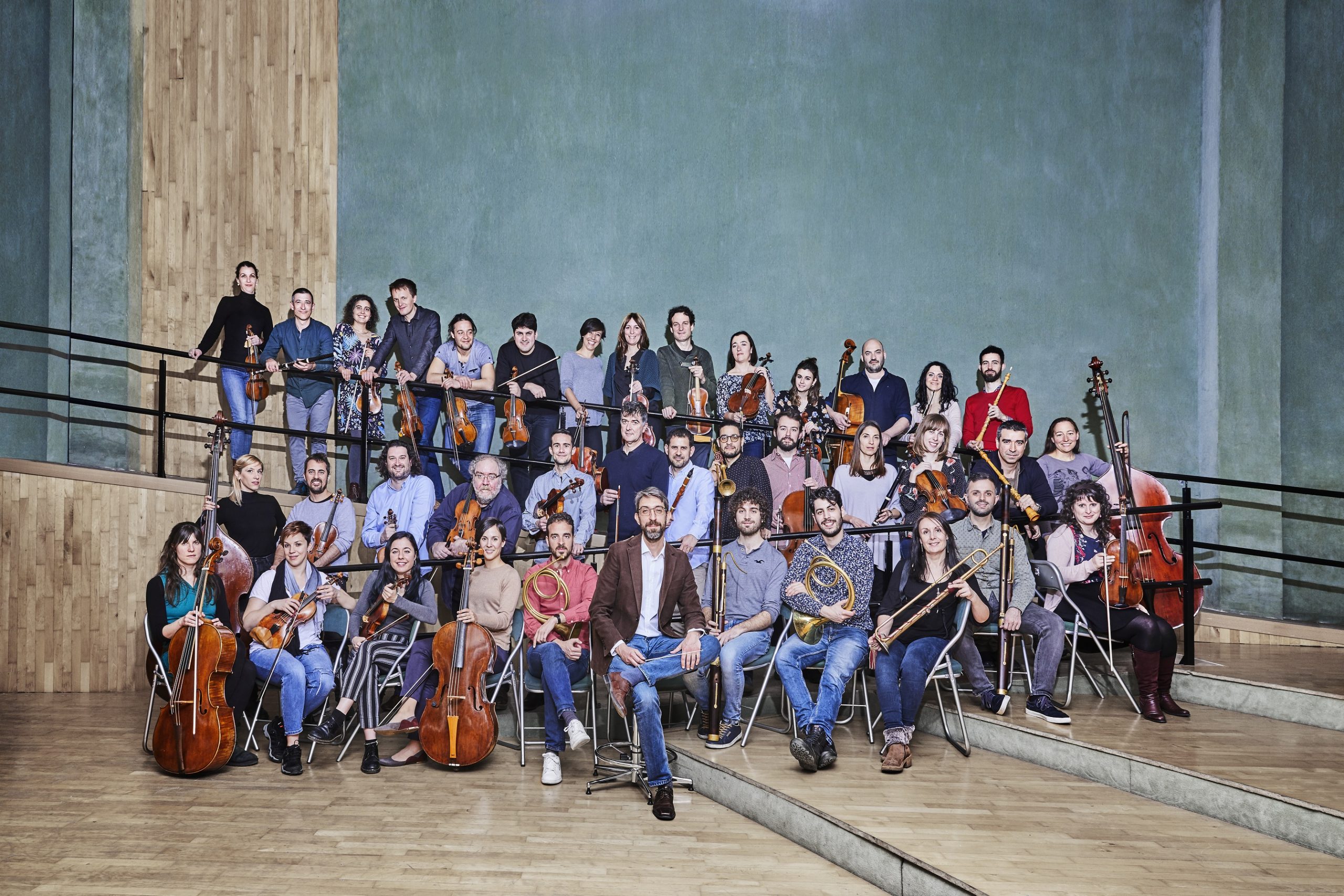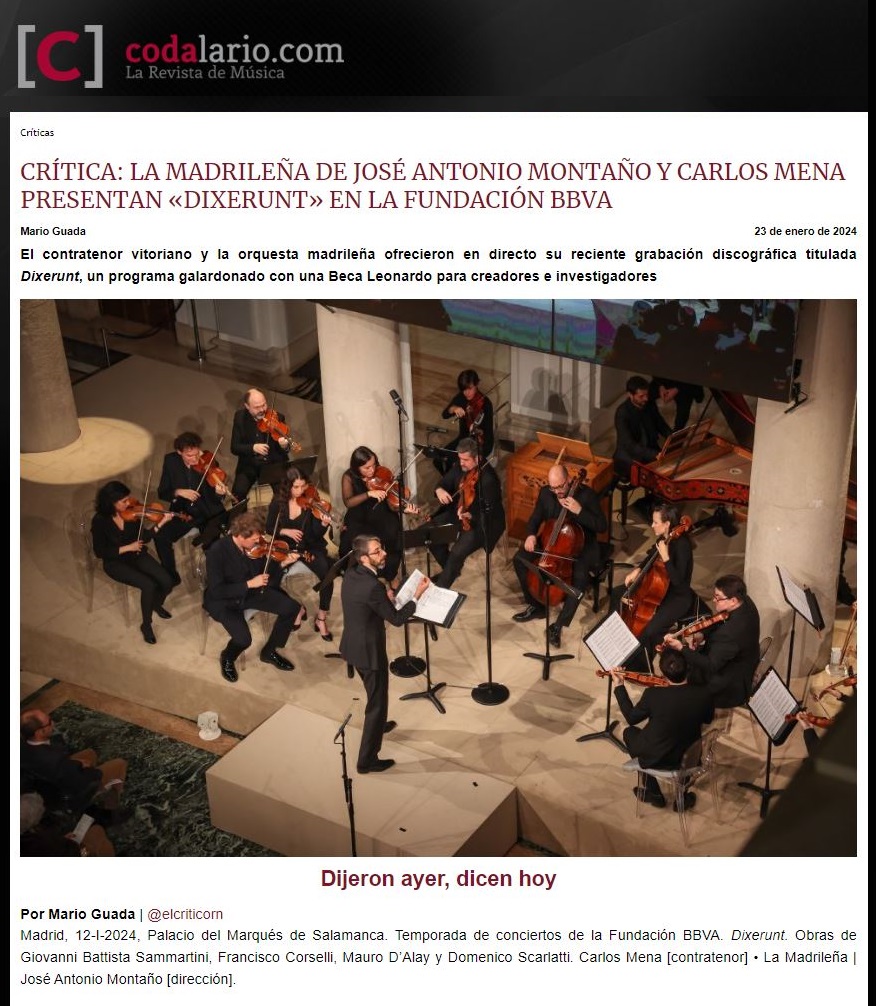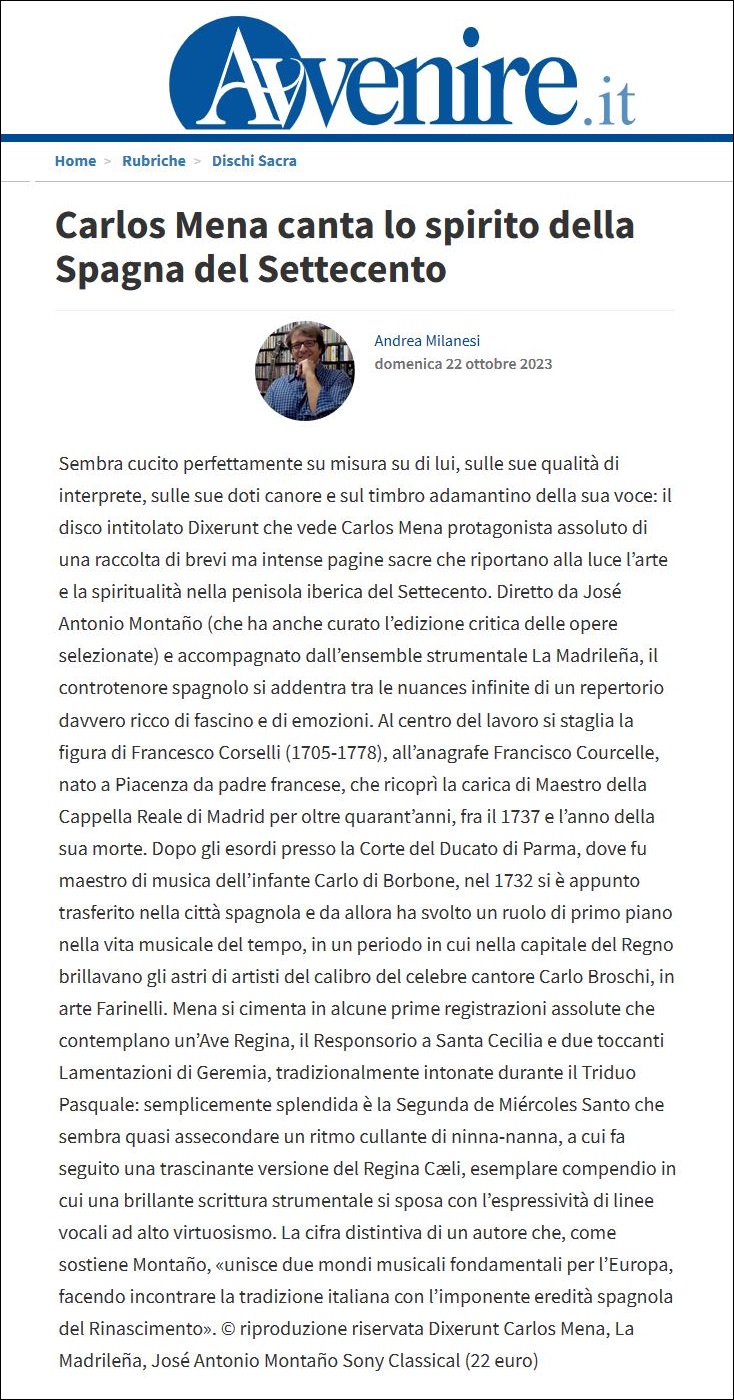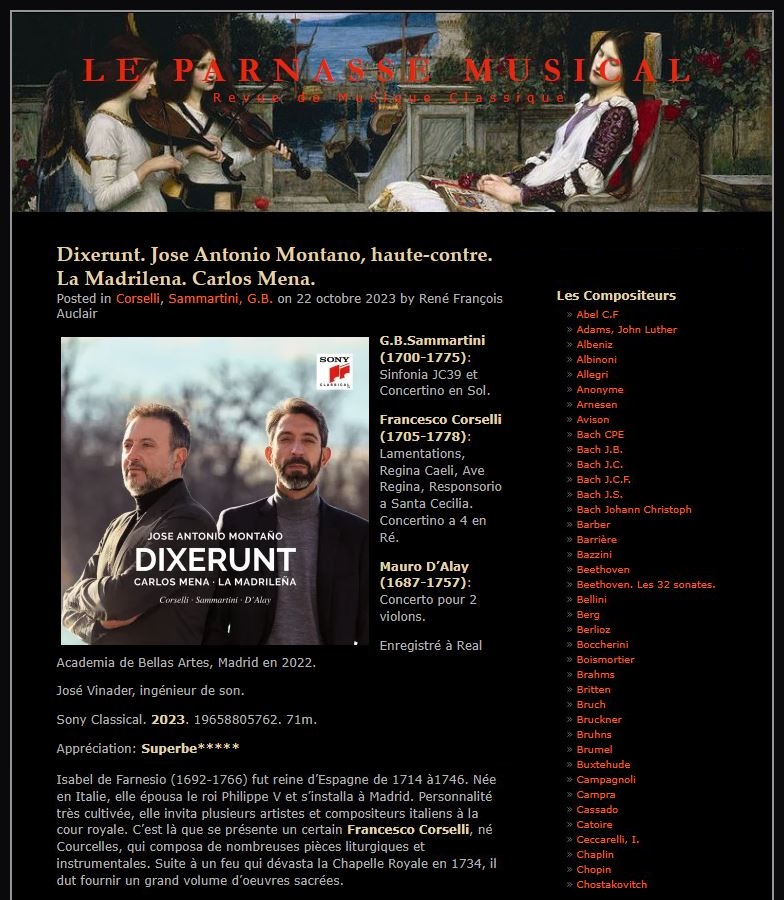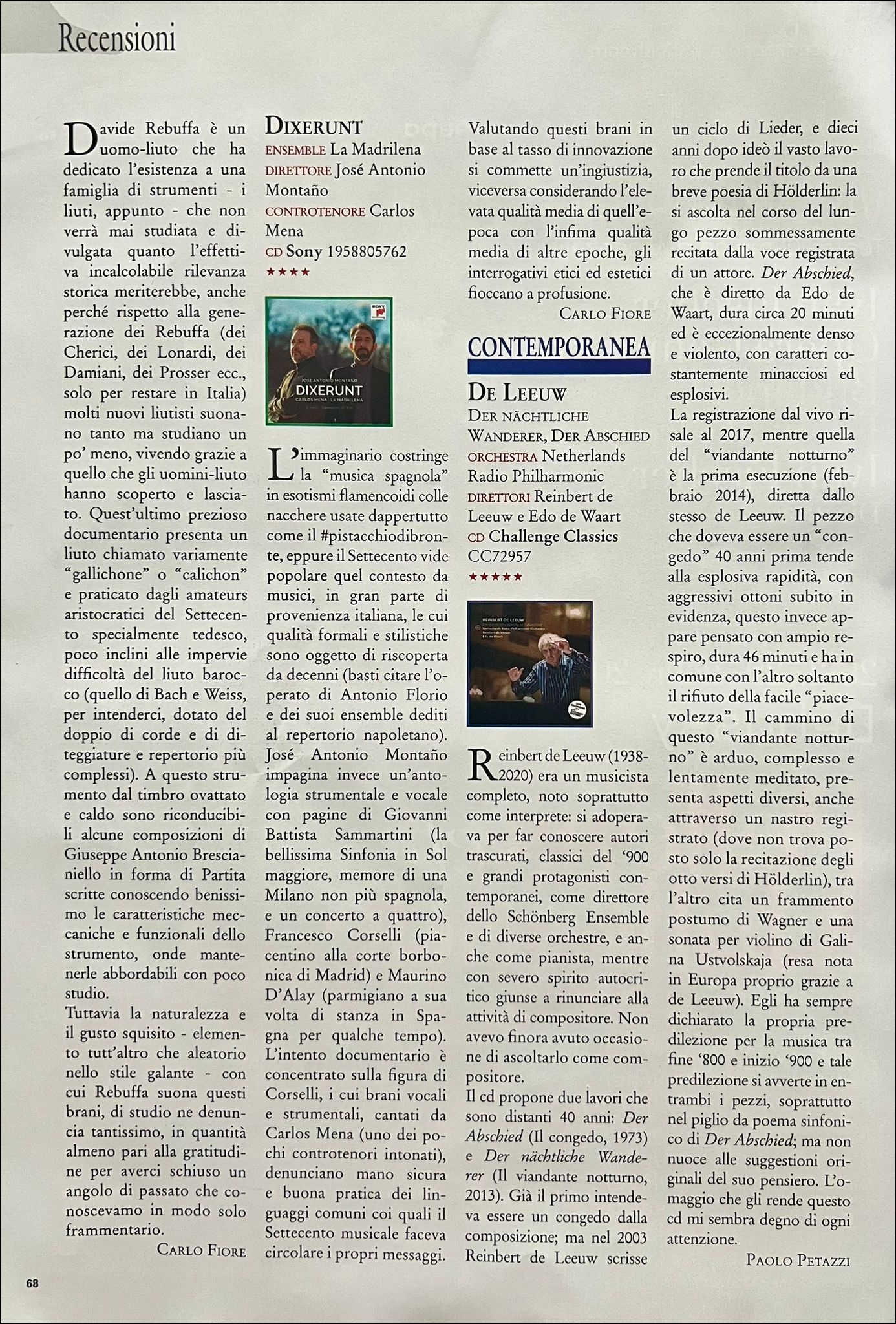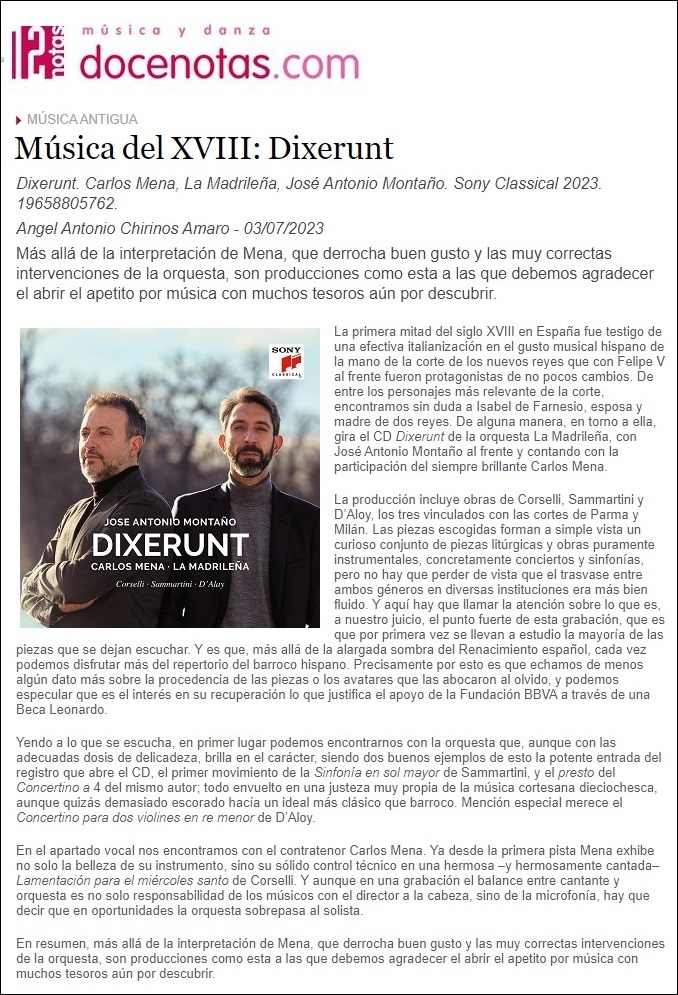DIXERUNT
LA MADRILEÑA RECORDINGS–ESPAÑOL-
MONTAÑO Y LA MADRILEÑA PRESENTAN EL ÁLBUM DIXERUNT CON EL PRESTIGIOSO SELLO DISCOGRÁFICO INTERNACIONAL SONY CLASSICAL
El director de orquesta, investigador y fundador de la orquesta de instrumentos de época La Madrileña José Antonio Montaño, debuta en la prestigiosa compañía Sony Classical con un exquisito trabajo de recuperación historicista producto de años de trabajo, que cobran vida en una cuidada grabación en torno a la figura del compositor Francesco Corselli, Maestro de la Real Capilla de Madrid durante cuarenta años.
Este lanzamiento discográfico cuenta con cinco primeras grabaciones mundiales para Alto solo y orquesta, interpretadas por una de las figuras más destacadas a nivel internacional de la escena historicista, el contratenor Carlos Mena y otras dos primeras grabaciones mundiales de los compositores Giovanni Battista Sammartini y Mauro D’Alay.
* Proyecto realizado con una Beca Leonardo a Investigadores y Creadores Culturales 2021 de la Fundación BBVA.
-ENGLISH-
MONTAÑO AND LA MADRILEÑA PRESENT THE ALBUM «DIXERUNT» WITH THE PRESTIGIOUS INTERNATIONAL RECORD LABEL SONY CLASSICAL
The conductor, Founder and artistic and musical director of La Madrileña period instrument orchestra, José Antonio Montaño, makes his debut at the prestigious Sony Classical company with an exquisite work of historicist recovery product of years of work, which comes to life in a careful recording around to the figure of the composer Francesco Corselli, Master of the Royal Chapel of Madrid for forty years.
This record release includes five world first recordings for Alto solo and orchestra, performed by one of the most outstanding international figures on the historicist scene, countertenor Carlos Mena, and two other world first recordings by composers Giovanni Battista Sammartini and Mauro D. ‘Alay.
* Work produced with the support of a 2021 Leonardo Grant for Researchers and Cultural Creators, BBVA Foundation.
DIXERUNT
Giovanni Battista Sammartini (1700/1-1775)
Sinfonia in Sol Maggiore J-C39
1. Allegro ma non tanto (04:11)
2. Grave (00:53)
3. Allegro assai (02:23)
4. Minuetto (02:58)
Francesco Corselli (1705-1778)
5. Lamentación 2ª de Miércoles Santo* (07:19)
6. Regina Caeli* (07:16)
Concertino a 4 en Re mayor
7. Allegretto (04:12)
8. Andantino (04:51)
9. Vivo, ma non precipitato (01:28)
10. Lamentación 2ª de Jueves Santo* (05:37)
11. Ave Regina* (06:02)
Giovanni Battista Sammartini (1700/1-1775)
Concertino a 4 stromenti in Sol Maggiore*
12. Allegro (03:26)
13. Affettuoso e piano (03:27)
14. Presto (02:10)
Francesco Corselli (1705-1778)
15. Responsorio a Santa Cecilia* (06:30)
Mauro D’Alay (c. 1687-1757)
Concerto per 2 violini in Re minore*
16. Allegro (03:14)
17. Largo (03:41)
18: Presto (02:13)
*(World premiere recording)
(Primera grabación mundial)
José Antonio Montaño
Countertenor / Contratenor
Carlos Mena
Ignacio Ramal (Violin II soloist in Concerto D’Alay)
Fumiko Morie
Lorenzo Cutillas
Adrián Pineda
Aglaya González (Viola soloist in Responsorio a Santa Cecilia)
Guillermo Martínez
Ester Domingo
Antonio Campillo
Laura Quesada
The splendour of the music of the Spanish court in the 18th century cannot be understood without the figure of Isabel de Farnesio. Having been educated in the manner fitting for noble women, she learnt geography, history, grammar, rhetoric and came to master seven languages. She also received musical, dance and artistic training, learning to play the clavichord and to dance and paint. In short, she was passionate about culture and the arts, and cultivated and used this knowledge to best serve and promote the monarchy.
The Queen favoured the presence of Italian artists at court. The most well-known of these was the singer Farinelli, who she regarded as a personal servant, a status hitherto unattained by another musician. She also made the wise decision to appoint Francesco Corselli (1705-1778). His father, the Frenchman Charles Courcelle, had been the dance tutor of Isabel de Farnesio at the court in Parma. Corselli also worked for the court in Parma as a teacher before he went to Madrid in 1733 with an already outstanding education and career behind him. Corselli is an undoubtedly essential name in 18th-century European music. He commanded all the latest aspects of a contemporary music dominated by Italian opera, for which he produced some works such as Farnace (1739) and Achille in Sciro (1744). These embody a purely joyful expression of feeling and emotions which he conveyed magnificently and also transferred to the religious works of the Royal Chapel. The music we hear on this CD is a fine example of such works. The religious genres also reflect the enormous value that the use of a large orchestra entails; rich and varied instrumental writing combined with the projection and expressiveness of the vocal lines, in many cases and as in these works, for solo voice.
Only one year after his arrival, Corselli had to take on the enormous challenge of rebuilding the music archive for the Royal Chapel, which had been destroyed by the fire that razed the Royal Alcazar of Madrid on Christmas Eve, 1734. From that point on, he worked tirelessly to create music for the liturgy. This CD features five pieces from his immense body of work that have been recorded for the first time and showcase the alto. The Royal Chapel singers were chosen from amongst the best international voices, especially castratos: Joseph Gallicani, José Pellegrini and Luigi Giorgi.
One of the most representative songs of the Catholic ritual for Easter Week is from the Lamentations of Jeremiah, which were performed during the Paschal Triduum. These are three songs for each of the three days of Easter and comprise a cycle of nine lamentations, conceived on the basis of a variety of musical aspects. Although the polychoral style was traditionally used, Corselli introduces the pieces for solo voices in different registers and with an equally characteristic use of the instruments. In addition to the strings, the orchestra alternates between woodwind, oboes, horns and flutes, as in the Second Lamentation of Holy Thursday, 1768.
The Marian Antiphons constitute another relevant genre of the liturgy. They are sung at the end of the service and there was a different one for each liturgical season: the Ave Regina Caelorum was performed from the Purification to Holy Thursday and the third, the Regina Caeli, from Holy Saturday to the Saturday following Pentecost, inclusive. The antiphons had a highly ornate style of song, often with long vocalizations for key words in the text, such as those included by Corselli in the final Hallelujah of Regina Caeli in 1750.
From 1778, the Responsory to Saint Cecilia was written for a viola public examination for the Royal Chapel. The responsories were pieces that commented on the reading of the day, which is why they are linked to a preceding text. Due to the function for which it was conceived, the viola has a very prominent role, especially at the instrumental beginning and in several sections in which it acts as an alter ego of the voice and in the cadences. It also performs at times an accompanying role within the string ensemble.
In addition to vocal music, the symphony and concert were genres that also were also developed greatly in the mid-18th century. The courtly palaces were a propitious environment in which they could be performed and enjoyed. During this period, there was a remarkable increase in academies and concerts. The new virtuoso performers were extremely popular with attendees. Corselli has left us fabulous works in this field also, such as the Concertino a 4 (1770), which, as with the responsory, was written for the viola public examination for the chapel orchestra. In this work, he emphasises the alto voice, which was highly prominent in court music with specialist performers and dedicated writing throughout the repertoire. This Concertino was the first work to be composed in Spain for four instrumental parts. With its independent lines for each instrument and three conventional movements (fast-slow-fast), its language is that of chamber music.
Sammartini (1700/1-1775) was the descendant of a French musician like Corselli. His career played out entirely in the city of his birth, Milan, where he held important positions. Sammartini received his early musical training from his father and his first professional steps were taken as an oboist for Saint Celsus church and the Royal Ducal Theatre orchestra. He was appointed master of the chapel choir for the Congregazione del Santissimo Entierro in 1728, a post in which he remained for his entire life. He was the city’s most important composer, and as well as premiering works at the Royal Ducal Theatre, he provided composition and musical direction for state religious ceremonies
His name is associated with the development of the symphony and he exerted a notable influence on musicians of his own time and those who followed, such as Haydn. His is the most important catalogue of symphonies from the mid-18th century. His work circulated throughout Europe and the aristocratic circles of Madrid before the Viennese classics became the later masters of the genre.
The Concertino a 4 stromenti linked him once again to Corselli. However, Sammartini’s work has a more orchestral character and texture than that of Corselli, which is more in the style of chamber music. Although some of his symphonies include wind instruments, many of them, like this one, Symphony in G Major J-C39, were written for strings: the same template as the Concertino. His orchestral music is transparent and brilliant, with rhythmic effects and continuous changes that confer upon the works a great sense of vitality and dynamism.
With further assistance from Queen Isabel de Farnesio, Mauro d’Alay (c. 1687-1757), known as Maurino, also attended the court. A virtuoso of the violin, he too was born in Parma. He accompanied the princess to Madrid in 1714 for her marriage to Philip V of Spain. After several return journeys to Madrid and throughout the continent (he was in London and Germany, and published in Amsterdam), he entered the service of the Queen on 9 May, 1740, with a very highly salary as the court’s first-violin player. As well as the Queen, Corselli also intervened to appoint D’Alay as a violinist for the premiere of his great opera, Farnace. Both men would have been in Parma at the Steccata church in the same time: around 1730. Both Corselli and D’Alay earned the Queen’s trust, and were chosen by her as music teachers for the princes, a position of the highest importance at court.
D’Alay remained in Spain until the beginning of the reign of the new monarchs, Ferdinand VI and Maria Barbara de Bragança. They were great music lovers who retained musicians like Farinelli and Corselli in their service, although this was not the case of D’Alay. He did not follow the Queen Mother Isabel in her retirement at La Granja, but returned to Italy and died in Parma in 1757.
In addition to being a performer, he was an excellent composer of vocal works, sonatas and violin concertos. This CD includes one of his vibrant concerts in the style of Vivaldi, who was one of his greatest influences, as can be seen in his music. This concerto in three movements for two violins builds on the dialogue between the two soloists and has a strong rhythmic component: the engine that drives the development of the form through the repetition of characteristic motifs typical of Italian instrumental music of the period.
This recording reflects the wide and varied range of genres and styles of the mid-18th century, which saw the emergence of high-quality music that can now be heard for the first time.
Judith Ortega
El esplendor de la música de corte española en el siglo XVIII no se puede entender sin la figura de Isabel de Farnesio. Con una exquisita formación propia de las mujeres de la realeza, aprendió geografía, historia, gramática, retórica, y llegó a dominar siete idiomas. La música, la danza y la formación artística también estuvieron presentes: aprendió a tocar el clavicordio y también a bailar y a pintar. En definitiva, una apasionada de la cultura y las artes que supo cultivar y utilizar como un medio al servicio de la representación de la majestad real.
La reina impulsó la presencia de los artistas italianos en la corte, cuyo nombre más conocido es el del cantante Farinelli, a quien reconoció como criado familiar, un estatus nunca alcanzado por otro músico. También tomó la sabia decisión de contratar a Francesco Corselli (1705-1778). Su padre, el francés Charles Courcelle, había sido maestro de danza de Isabel de Farnesio en la corte de Parma. Para la corte de Parma también trabajó Corselli como maestro antes de su llegada a Madrid en 1733, con una formación y trayectoria ya notables. Sin duda, Corselli es un nombre imprescindible en la música europea del siglo XVIII. Asimiló todas las novedades de la música del momento, dominada por la ópera italiana de la que él mismo nos dejó algunos títulos como Farnace (1739) o Achille in Sciro (1744), puro gozo de expresión de los afectos y las emociones manejados de manera genial y que trasladó también a las obras religiosas de la Real Capilla. La música que escuchamos es una buena muestra de ello. Los géneros religiosos también incorporan la enorme riqueza que supone el uso de una amplia orquesta, una escritura instrumental rica y variada junto al vuelo y expresividad de las líneas vocales, en muchos casos, como en estas obras, para voz solista.
Solo un año después de su llegada, Corselli debió asumir el enorme reto de reconstruir el archivo de música para la Real Capilla destruido tras el incendio que asoló el Alcázar de Madrid la nochebuena de 1734. Desde entonces se dedicó de manera incansable a la creación de música para la liturgia. De su inmenso corpus se incluyen en este disco cinco obras, grabadas por primera vez, que tienen como protagonista la voz de alto. Los cantores de la Real Capilla eran escogidos entre las mejores voces internacionales, con preferencia por los castrados, como Joseph Gallicani, José Pellegrini o Luigi Giorgi.
Uno de los cantos por excelencia del ritual católico para la Semana Santa es el de las lamentaciones de Jeremías que se interpretan durante los oficios de tinieblas para el Triduo Santo. Tres cantos para cada uno de los días que conforman un ciclo de nueve lamentaciones, un ciclo que se concibe sobre la base de una variedad de elementos musicales. Aunque tradicionalmente se empleaba el estilo policoral, Corselli introduce las piezas para voces solistas de diferentes registros y un uso igualmente característico de los instrumentos, con una orquesta que además de la cuerda alterna la presencia de vientos, oboes, trompas o flautas, como en la Lamentación 2ª de Jueves Santo de 1768.
Las antífonas marianas constituyen otro género relevante de la liturgia. Se cantan al término del oficio y había una diferente para cada tiempo litúrgico: el Ave Regina Caelorum, se interpretaba desde la Purificación hasta el Jueves Santo y la tercera, el Regina Caeli, desde el Sábado Santo hasta el sábado siguiente a Pentecostés, inclusive. Las antífonas tenían un estilo de canto muy ornamentado, a menudo con largas vocalizaciones en palabras clave del texto, como las que incluye Corselli en el Aleluya final del Regina Caeli en 1750.
El responsorio a Santa Cecilia de 1778 está escrito para una oposición de viola de la Real Capilla. Los responsorios eran piezas que comentaban la lectura del día, por lo que se vinculan a un texto precedente. Debido a la función con la que se concibió, la viola tiene un papel muy destacado especialmente en el inicio instrumental, en varias secciones en las que funciona como alter ego de la voz y en las cadencias. También ejerce en algunos momentos su rol de acompañamiento dentro del conjunto de cuerda.
No solo la música vocal, también la sinfonía y el concierto fueron géneros que gozaron de un gran desarrollo en el periodo central del siglo XVIII que encontraron en los palacios cortesanos un ambiente propicio para su interpretación y escucha. En estos años las academias y los conciertos aumentan notablemente y los nuevos intérpretes virtuosos hacen las delicias de los asistentes. Corselli nos ha dejado también obras fabulosas en este terreno, como el Concertino a 4 (1770), escrito al igual que el responsorio para la oposición a viola de la orquesta de la capilla. Pone el foco así en la voz de alto, que tuvo mucho protagonismo en la música de corte con intérpretes especializados y una escritura específica en todo el repertorio. Este Concertino es la primera obra a 4 partes instrumentales compuesta en España. Presenta un lenguaje camerístico, con líneas independientes para cada instrumento y consta de los tres movimientos convencionales, rápido-lento-rápido.
Descendiente de un músico francés al igual que Corselli, Sammartini (1700/1-1775) desarrolló toda su carrera en su ciudad natal, Milán, en la que ocupó los puestos principales. Sammartini inició su formación musical de la mano de su padre. Sus primeros pasos profesionales fueron como oboísta en la iglesia de San Celso y en la orquesta del Teatro Ducal. Fue nombrado maestro de capilla de la Congregazione del Santissimo Entierro en 1728, cargo en el que permaneció el resto de su vida. Fue el compositor más importante de la ciudad, y además de estrenar obras en el Teatro Ducal se ocupó de la composición y dirección musical en ceremonias religiosas de Estado.
Su nombre está asociado al desarrollo de la sinfonía y ejerció una notable influencia en músicos de su época y posteriores, como Haydn. Cuenta con el catálogo más importante de sinfonías de mediados del XVIII y su obra circuló por toda Europa, también en los ambientes aristocráticos madrileños, antes de que los clásicos vieneses se erigieran para la posteridad en los maestros del género.
El Concertino a 4 stromenti lo vincula nuevamente a Corselli, si bien el de Sammartini tiene un carácter y textura más orquestal que el de este, de estilo más camerístico. Aunque algunas de sus sinfonías incluyen vientos, buena parte de ellas, como la que escuchamos aquí, Sinfonia in Sol maggiore J-C39, las escribe para cuerdas, la misma plantilla que el concertino. Su música orquestal es transparente y brillante, con efectos rítmicos y cambios continuos que aportan gran vitalidad y dinamismo a las obras.
También por mediación de la reina Isabel de Farnesio llegó a la corte Mauro d’Alay (c. 1687-1757), conocido como Maurino, virtuoso del violín y también originario de Parma. Viajó con la princesa a Madrid en 1714 con motivo de su matrimonio con el rey Felipe V. Después de varias idas y venidas a Madrid además de viajes por el continente (estuvo en Londres, en Alemania y publicó en Ámsterdam) entró al servicio de la reina el 9 de mayo de 1740, con un sueldo altísimo como primer violín de la corte. Además de la propia reina, Corselli pudo interceder para contratar a D’Alay como violinista para el estreno de su gran ópera Farnace, ambos habrían coincidido en Parma en la iglesia de la Steccata hacia 1730. Tanto Corselli como D’Alay merecieron la confianza de la reina eligiéndolos como maestros de música de los infantes, un puesto de la máxima relevancia en la corte.
Permaneció en España hasta el inicio del reinado de los nuevos monarcas, Fernando VI y María Bárbara de Braganza, grandes melómanos que mantuvieron a músicos como Farinelli y Corselli a su servicio, pero no fue el caso de D’Alay, quien tampoco siguió en su retiro a la reina madre Isabel en La Granja, sino que regresó a Italia y falleció en Parma en 1757.
Además de intérprete fue un excelente compositor de obras vocales, sonatas y conciertos para violín. Aquí escuchamos uno de sus vibrantes conciertos, al estilo de Vivaldi, que le influyó notablemente como se aprecia en su música. Este concierto en tres movimientos para dos violines explota el diálogo entre los dos solistas, tiene un fuerte componente rítmico, ese motor que impulsa el desarrollo de la forma a través de la repetición de motivos característicos típico de la música instrumental italiana del periodo.
Este disco refleja la amplia y variada constelación de géneros y estilos del periodo central del siglo XVIII que alumbró músicas de gran calidad que pueden ahora escucharse por primera vez.
Judith Ortega
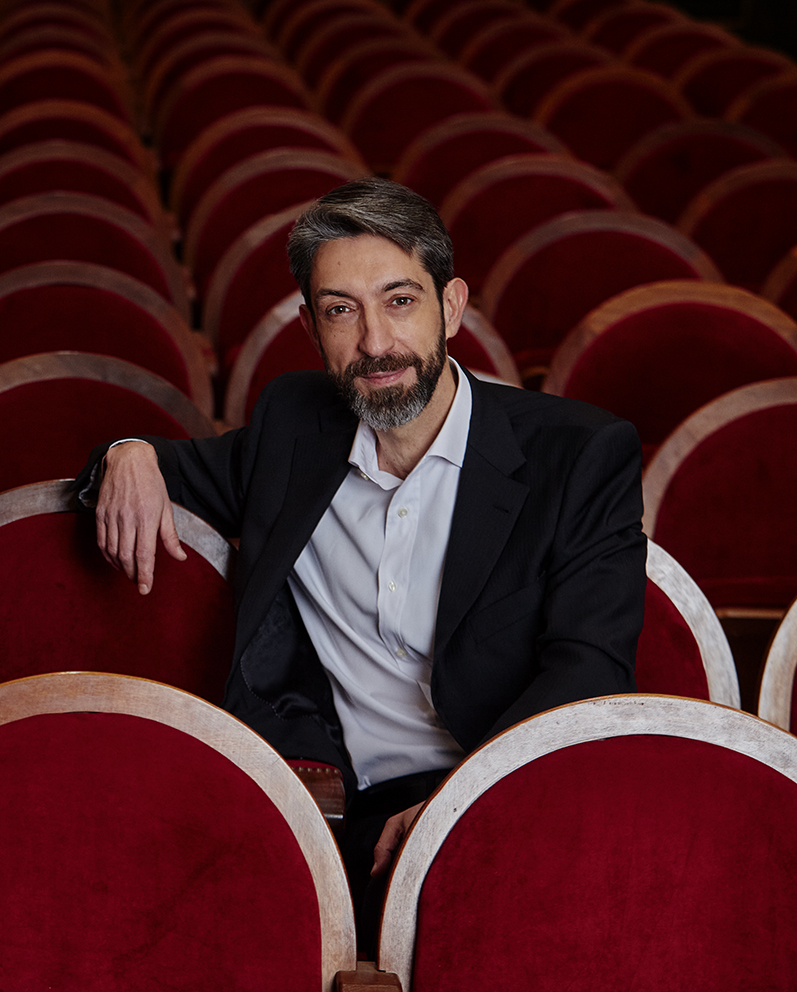 JOSÉ ANTONIO MONTAÑO, Conductor / Director
JOSÉ ANTONIO MONTAÑO, Conductor / Director
-ENGLISH-
José Antonio Montaño, considered by the musical press as “one of the Spanish conductors with the most projection of the moment“, develops a successful and versatile career in theatres and auditoriums of international prestige through all genres (opera, ballet and symphonic) covering an extensive repertoire ranging from the baroque to contemporary premieres. In the operatic field of early music, he has directed titles such as: La vera costanza or Il mondo della luna by Haydn, Don Giovanni by Mozart, Il matrimonio segreto by Cimarosa, Il tutore burlato by Vicente Martín y Soler, L‘Orfeo by Monteverdi, Dido & Aeneas by Purcell, La contadina by Hasse, La serva padrona by Pergolesi, Il sacrifizio di Abramo by Camille de Rossi, which combines with others such as Il barbiere di Siviglia and Il viaggio a Reims by Rossini, Don Pasquale and Rita by Donizetti, Don Giovanni Tenorio by R. Carnicer, I Puritani by Bellini or La Bohème by Puccini to name but a few. In 2016 he founded the orchestra of period instruments La Madrileña, with which he developed various projects of interpretation and musicological research, with repertoires from the 18th century, in outstanding theatres, auditoriums and festivals.
-ESPAÑOL-
José Antonio Montaño, considerado por la prensa musical como “uno de los directores de orquesta españoles con más proyección del momento”, desarrolla una exitosa y versátil carrera en teatros y auditorios de prestigio internacional a través de todos los géneros (ópera, ballet y sinfónico) abarcando un extenso repertorio que va desde un primer barroco hasta estrenos contemporáneos absolutos. En el campo operístico de música antigua, ha dirigido títulos como: La vera costanza o Il mondo della luna de F. J. Haydn, Don Giovanni de W. A. Mozart, Il matrimonio segreto de D. Cimarosa, Il tutore burlato de V. Martín y Soler, L’Orfeo de C. Monteverdi, Dido & Aeneas de H. Purcell, La contadina de J. A. Hasse, La serva padrona de G. B. Pergolesi, Il sacrifizio di Abramo de C. de Rossi, que combina con otros como Il barbiere di Siviglia e Il viaggio a Reims de G. Rossini, Don Pasquale y Rita de G. Donizetti, Don Giovanni Tenorio de R. Carnicer, I Puritani de V. Bellini o La Bohème de G. Puccini por citar solo algunos.En 2016 funda la orquesta de instrumentos de época La Madrileña, con la que desarrolla diversos proyectos de interpretación e investigación musicológica, con repertorios del siglo XVIII, en destacados teatros, auditorios y festivales.
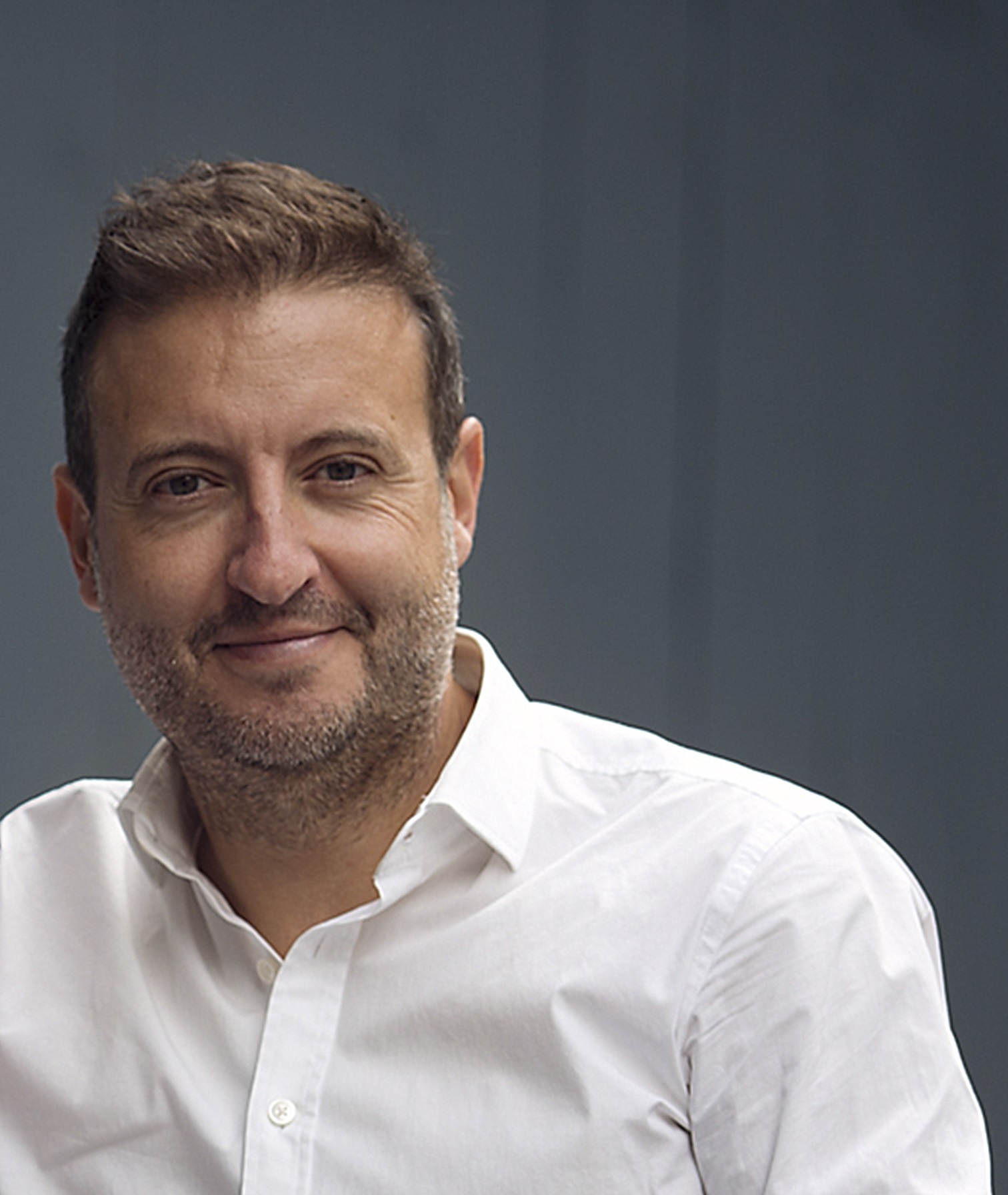 CARLOS MENA, Countertenor / Contratenor
CARLOS MENA, Countertenor / Contratenor
-ENGLISH-
Trained at the Schola Cantorum Basiliensis (Basel, Switzerland) where he studied with his teachers R. Levitt and R. Jacobs, Carlos Mena is a regular guest at concert halls such as the Musikverein in Vienna, Philharmonie in Berlin, Teatro Colón in Buenos Aires, Bellas Artes of Mexico DF Opera City Hall of Tokyo. Osaka Symphony Hall, Sidney Opera House… Mena has played the main roles of Handel’s Radamisto and Rinaldo at the Salzburg Festival and Concertgebouw in Amsterdam, Britten’s A MidsummerNight’s Dream at the Teatro Real in Madrid, Mozart’s Ascanio in Alba at the Barbican Center of London among many others roles. He has recorded around 50 recitals for Harmonia Mundi, Sony, Mirare, IBS Classical, Passacaille… winning numerous international awards. He has been resident artist of BOZAR in Brussels, the National Center for Musical Diffusion in Madrid and the City of Granada Orchestra.Carlos Mena is equally prolific as conductor with orchestras such as the Portuguese Symphony, OCRTVE Ciudad de Granada, and the symphonies of the Principality of Asturias, Córdoba, Navarra, Bilbao and Galicia.
-ESPAÑOL-
Formado por la Schola Cantorum Basiliensis (Basilea, Suiza) donde estudió con sus maetros R. Levitt y R. Jacobs, Carlos Mena es invitado regularmente a salas de conciertos como la Musikverein de Viena, Philarmonie de Berlín,Teatro Colón de Buenos Aires, Bellas Artes de México D.F. Opera City Hall de Tokyo. Osaka Symphony Hall, Sidney Opera House… Mena ha interpretado los roles principales de Radamisto y Rinaldo de Haendel en el Festival de Salzburgo y Concertgebouw de Amsterdam, A MidsummerNight’s Dream de Britten en el Teatro Real de Madrid, Ascanio in Alba deMozart en el Barbican Center de Londres entre otros muchos roles. Ha grabado alrededor de 50 recitales para Harmonia Mundi, Sony, Mirare, IBS Classical, Passacaille… ganando numerosos premios internacionales. Ha sido artista residente del BOZAR de Bruselas, del Centro Nacional de Difusión Musical de Madrid y de la Orquesta Ciudad de Granada. Carlos Mena se prodiga igualmente como director de orquesta con orquestas como la Sinfónica de Portugal, OCRTVE Ciudad de Granada, y las sinfónicas de Principado de Asturias, Córdoba, Navarra, Bilbao y Galicia.
-ENGLISH-
La Madrileña is an orchestra of period instruments created and directed by José Antonio Montaño. Its objective is to recover and disseminate the Spanish musical heritage, mainly from the 18th century. Paying special attention to opera and zarzuela by Spanish authors, and using specific instruments from both the baroque and classical repertoires, it has performed in outstanding theatres and auditoriums such as the Teatro Real Madrid, the Auditorio Nacional de Música, the Real Academia de Bellas Artes de San Fernando or the Palacio de Cibeles in Madrid, and participating in festivals such as the International Festival of Sacred Art of the Community of Madrid or the Music Week 2018 of the Real Maestranza de Caballería de Ronda (Málaga).
His concerts have been broadcasted by Radio Nacional de España. He usually combines in his programmes composers such as W. A. Mozart, Jospeh Haydn or Luigi Boccherini with talented Spaniards such as Vicente Martín y Soler or José de Nebra.
This recording of de Nebra‘s Oficio y Misa de difuntos is the first record project of La Madrileña and is also the world premiere of this work with which the group wants to contribute to the dissemination of the unpublished Spanish musical heritage.
-ESPAÑOL-
La Madrileña es una orquesta de instrumentos de época creada y dirigida por José Antonio Montaño. Tiene como objetivo la recuperación y difusión del patrimonio musical, principalmente del siglo XVIII. Prestando una especial atención a la ópera y zarzuela de autores españoles, y sirviéndose de instrumentos concretos tanto del repertorio barroco como del clásico, ha actuado en destacados teatros y auditorios como el Teatro Real, el Auditorio Nacional de Música, la Real Academia de Bellas Artes de San Fernando o el Palacio de Cibeles en Madrid, y participando en Festivales como el Festival Internacional de Arte Sacro de la Comunidad de Madrid o la Semana de la Música 2018 de la Real Maestranza de Caballería de Ronda (Málaga).
Sus conciertos han sido retransmitidos por Radio Nacional de España. Habitualmente combina en sus programas autores internacionalmente reconocidos como W. A. Mozart, F. J. Haydn o L. Boccherini con otros españoles de gran talento como V. Martín y Soler o el propio J. de Nebra. Esta grabación del Oficio y Misa de difuntos de J. de Nebra es el primer proyecto discográfico de la Orquesta La Madrileña y es también la primicia mundial de esta obra con la que la agrupación quiere contribuir a la divulgación del patrimonio musical español inédito.
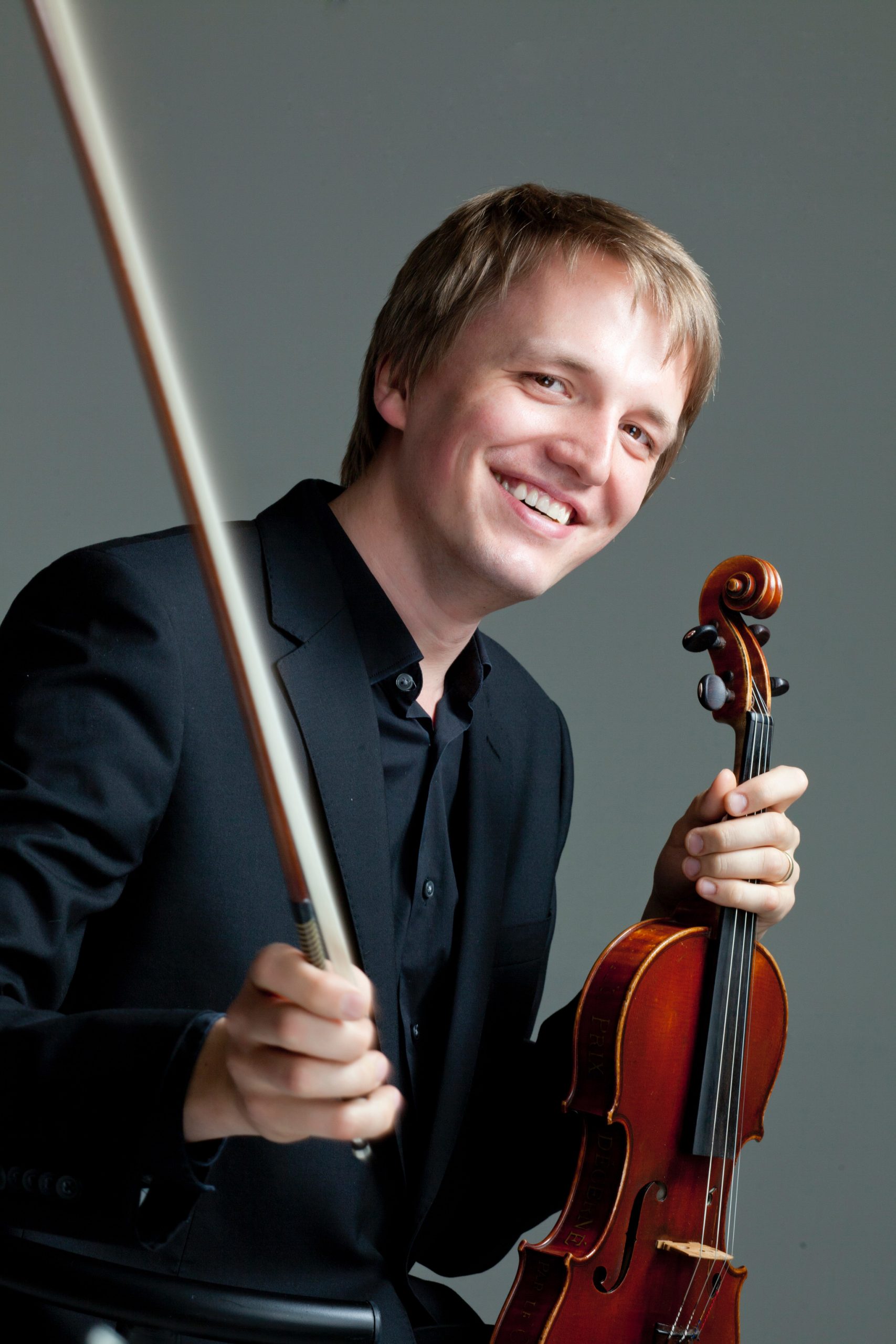 MAXIM KOSINOV, Violinist / Violinista
MAXIM KOSINOV, Violinist / Violinista
-ENGLISH-
Maxim Kosinov is a violinist, known for his ability to captivate audiences with his combination of virtuosity and sophistication. Born in St Petersburg, he combines the great Russian musical tradition with wide ranging experience gained through a myriad of artistic collaborations in Europe. Strongly influenced by Reinhard Goebel, he is developing his artistic career as a soloist and orchestra leader and is comfortable with both modern and baroque violin.
Since his first solo recital at the age of five in his hometown, Maxim has regularly appeared internationally in some prestigious venues in Europe and Asia. Maxim is the concertmaster of La Madrileña since its creation in 2016 in Madrid. Since the 21/22 season, Maxim holds the position of associate concertmaster with the SWR Symphony Orchestra Stuttgart and appears as a guest concertmaster with orchestras such as the Spanish National Orchestra, the Lucerne Symphony Orchestra, Orchestre de la Suisse Romande and the Sresdner Philharmonie to name just a few.
-ESPAÑOL-
Maxim Kosinov es un violinista conocido por su capacidad para cautivar al público gracias a una combinación de virtuosismo y sofisticación. Nacido en San Petersburgo en 1983, combina la gran tradición musical rusa con una amplia experiencia adquirida a través de un sinfín de colaboraciones artísticas en Europa. Fuertemente influenciado por Reinhard Goebel, actualmente está desarrollando su carrera artística como solista y concertino de orquesta, tanto con violín barroco como moderno.
Desde su primer recital en solitario a la edad de cinco años en su ciudad natal, Maxim se ha presentado regularmente a nivel internacional en prestigiosos lugares de Europa y Asia. Maxim es concertino de La Madrileña desde su creación en 2016 en Madrid. Desde la temporada 21/22, Maxim ocupa el cargo de concertino asociado de la SWR Symphony Orchestra de Stuttgart y figura como concertino invitado con orquestas como la Orquesta Nacional de España, la Orquesta Sinfónica de Lucerna, la Orchestre de la Suisse Romande y la Sresdner Philharmonie para nombrar solo algunos. www.maximkosinov.com
 IGNACIO RAMAL, Violinist / Violinista
IGNACIO RAMAL, Violinist / Violinista
-ENGLISH-
Ignacio Ramal, violinist specialized in historically informed performance, studied with professors Manfredo Kraemer and Enrico Onofri, being also influential in his path teachers like Emilio Moreno and Pedro Memelsdorff. He is regularly invited as soloist or concertmaster in various groups, such as the YOCPA orchestra (Jordi Savall), La Madrileña, Bachcelona Consort, Nereydas, Collegium Musicum Madrid, Orquestra del Miracle or Camerata Antonio Soler, with which he has recorded two of Gaetano Brunetti’s concertante symphonies for two violins as soloist as well as several records of Iberian classicism repertoire.
He collaborates regularly with groups such as Le Concert des Nations, Arlequin Philosophe, Orquesta Barroca de Sevilla or La Real Cámara, a group with which he has had the opportunity to give a concert with the Stradivarius Palatinos in Madrid. Besides also collaborating with other of the most relevant groups of the Spanish and European scene, he is a member of the ensemble La Vaghezza and artistic director of the group The Ministers of Pastime.
-ESPAÑOL-
Ignacio Ramal, violinista especializado en la interpretación históricamente informada, se formó con los profesores Manfredo Kraemer y Enrico Onofri, siendo también influyentes en su camino profesores como Emilio Moreno o Pedro Memelsdorff. Es invitado como solista o concertino en diversos grupos, como la orquesta YOCPA (Jordi Savall), La Madrileña, Bachcelona Consort, Nereydas, Collegium Musicum Madrid, Orquestra del Miracle o Camerata Antonio Soler, con la que ha grabado dos de las sinfonías concertantes de Gaetano Brunetti para dos violines como solista además de varios discos de repertorio del clasicismo ibérico.
Colabora habitualmente con grupos como Le Concert des Nations, Arlequin Philosophe, la Orquesta Barroca de Sevilla o La Real Cámara, grupo con el que ha tenido la oportunidad de dar un concierto con los Stradivarius del Cuarteto Palatino de Madrid. Además de colaborar con otros de los grupos más destacados del panorama español y europeo, es miembro del ensemble La Vaghezza y director artístico del grupo The Ministers of Pastime.
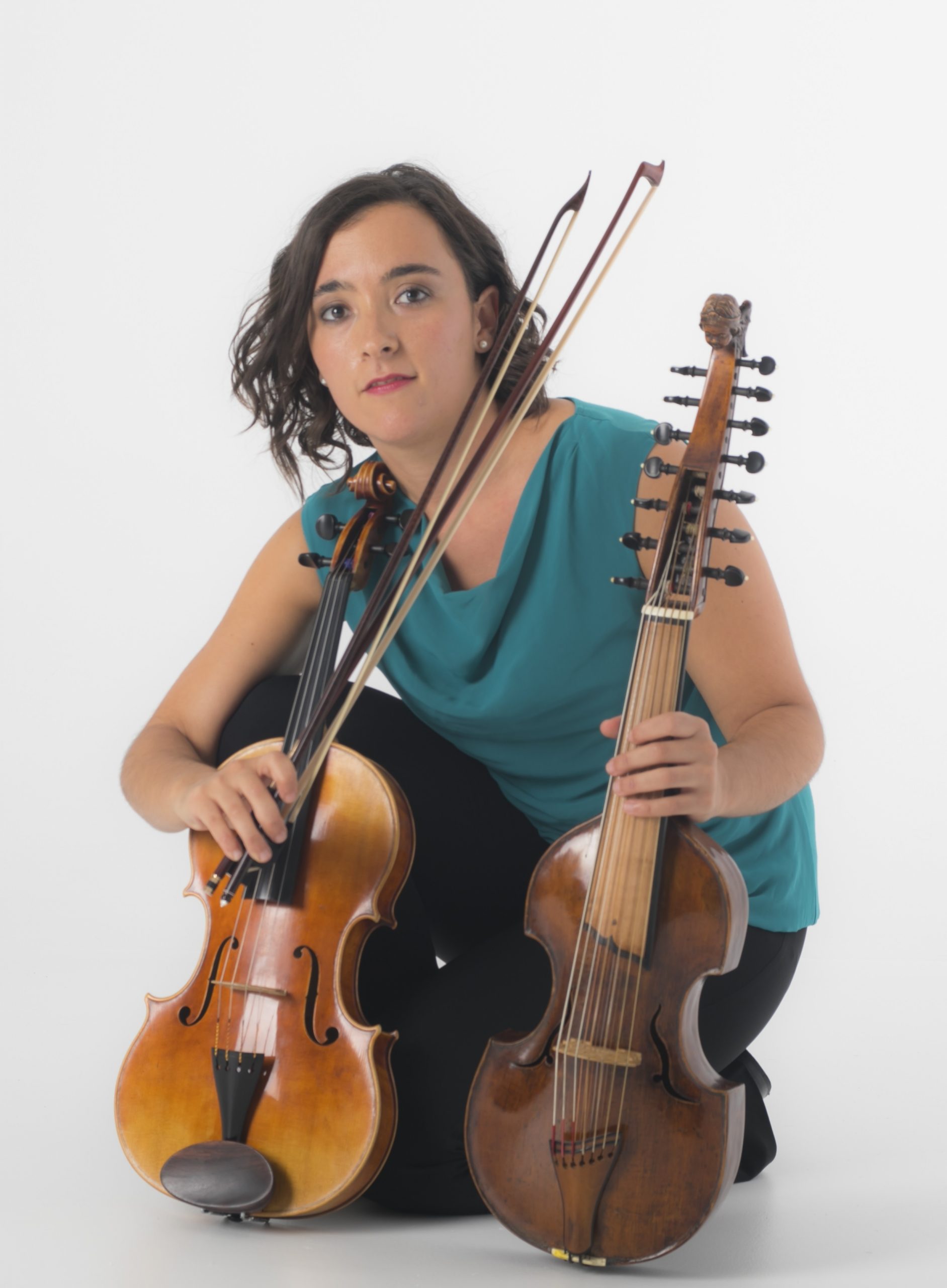 AGLAYA GONZÁLEZ, Violist / Violista
AGLAYA GONZÁLEZ, Violist / Violista
–ENGLISH-
Aglaya González studied viola at R.C.S.M.M., E.S.M. “Reina Sofía”, Indiana University, HfM Detmold and HfMDK Frankfurt am Main, master degrees in solo performance, early music and contemporary music (HIP & IEMA) and PhD at Alfonso X “El Sabio” University. As a versatile musician, she is a founding member of ZnO, Améi string quartet and Ensemble Tempus Konnex and collaborates with groups like Ensemble Modern, Ensemble Recherche, Taller Sonoro, Zahir Ensemble, Vertixe Sonora Ensemble and Klangforum Wien, among others. Furthermore, she plays fidle, viola d’amore and baroque viola in La Madrileña, Bachorchester Wiesbaden, Freiburger Bachorchester, Orquesta Barroca de Sevilla, L’Espagna, Stagione Frankfurt or Le Concert Lorrain. Since 2018, she is combining her artistic activity with her other passion: the pedagogy, as viola Professor at C.S.M. "Manuel Castillo. She also teaches music courses and gives lectures at universities such as Mozarteum Salzburg, UAX, Hong Kong Baptist University, The Royal Danish Academy of Music and numerous music conservatories.
-ESPAÑOL-
Aglaya González se forma como violista en el R.C.S.M.M., E.S.M. “Reina Sofía”, Universidad de Indiana, HfM Detmold y HfMDK Frankfurt am Main, se especializa en la música antigua y contemporánea (HIP y IEMA) y es doctora por la Universidad Alfonso X “El Sabio”. Como músico polifacético funda ZnO, AMÉI Quartett y Ensemble Tempus Konnex y colabora con grupos de música contemporánea como el Ensemble Modern, Ensemble recherche, Taller Sonoro, Zahir Ensemble, Vertixe Sonora Ensemble y Klangforum Wien entre otros. Toca además la fídula, la viola d’amore y la viola barroca en diversas agrupaciones como La Madrileña, Bachorchester Wiesbaden, Freiburger Bachorchester, Orquesta Barroca de Sevilla, L’Espagna , Stagione Frankfurt o Le Concert Lorrain. Desde 2018 combina su actividad artística con su otra pasión, la pedagogía, como Catedrática de viola en el Conservatorio Superior de Música “Manuel Castillo” de Sevilla. Además imparte cursos y conferencias en universidades como Mozarteum Salzburg, UAX, Hong Kong Baptist University, The Royal Danish Academy of Music y numerosos conservatorios. www.aglayagonzalez.com
Codalario – La Madrileña de José Antonio Montaño y Carlos Mena presentan «DIXERUNT» en la Fundación BBVA
Madrid, 12-I-2024, Palacio del Marqués de Salamanca. Temporada de conciertos de la Fundación BBVA. Dixerunt. Obras de Giovanni Battista Sammartini, Francisco Corselli, Mauro D’Alay y Domenico Scarlatti. Carlos Mena [contratenor] • La Madrileña | José Antonio Montaño [dirección].
«Este programa, que lleva por título Dixerunt y previamente había ya fructificado como una grabación homónima para Sony Classical, se presentó en directo y lo hizo en el lugar en el que precisamente nació, la Fundación BBVA, tras recibir en 2021 una Beca Leonardo dirigida a investigadores y creadores culturales en la categoría música y ópera, que dio la oportunidad a José Antonio Montaño de llevar a cabo el proyecto que tenía en mente, grabar por vez primera –junto a su agrupación historicista La Madrileña– algunas obras sacras en latín de Francisco Corselli, una de las grandes figuras de la música en la España de mediados del siglo XVIII, pero también un par de piezas instrumentales firmadas por dos autores italianos como fueron Giovanni Battista Sammartini y Mauro D’Alay, completando la grabación con otras obras orquestales no inéditas. Este programa de concierto difiere en algunas piezas de la grabación, esto es, no están todas las que son, pero sí son todas las que están, al menos para hacerse una idea concreta del proyecto, con la inclusión de una exquisita pieza de Scarlatti hijo para cerrar el programa y que no forma parte de este disco.»
«El concierto se inició con una obra orquestal del italiano Giovanni Battista Sammartini (c. 1700/01-1775), la Sinfonía en sol mayor, J-C 39, que presenta cuatro movimientos. Sin ser el patio central del Palacio del Marqués de Salamanca –sede en Madrid de la Fundación BBVA y donde se desarrolla su ciclo de conciertos– el mejor sitio posible para una agrupación orquestal de medianas dimensiones –más aun con una tarima enmoquetada que no favorece que el sonido corra en exceso–, la estructura cuadrangular del recinto y no contar con muchos asientos disponibles para el público ayudó a percibir una acústica algo más diáfana de lo esperado, por más que en algunos momentos se perdieron detalles que quizá debieron haberse articulado más para evitar cierta pastosidad general. El Allegro ma non tanto sirvió para calentar motores en una orquesta conformada para este concierto por una sección de cuerda relativamente ambiciosa [5/4/3/2/1], contando en el continuo, además de la cuerda grave, con clave y órgano –según en la ocasión–, además de archilaúd, aunque este último no en todas las piezas. Sonido del tutti de notable empaque, los diálogos entre los violines I y II –comandados con sabia mano por Maxim Kosinov e Ignacio Ramal respectivamente, solistas, además, en el concierto de D’Alay– llegaron bien construidos, con una elaboración inteligente de los recurrentes motivos que conforman este primer movimiento, además de un trabajo de dinámicas por planos bien elaborado. Estas obras de Sammartini todavía requieren de una línea de bajo asumible con el bajo continuo plenamente barroco, firmemente sustentado aquí por la sección de violonchelos a cargo de Guillermo Martínez y Ester Domingo, junto al contrabajo de Alberto Jara, que se defendió excelentemente bien, a pesar de su posición algo incómodo en el extremo derecho y al fondo de la orquesta, algo desconectado de los chelos. Muy correcto y solvente, como es habitual en él, Jorge López-Escribano al teclado –clave en las obras orquestales y órgano positivo en las piezas sacras, por norma general–. El Grave subsiguiente, un movimiento de transición puro entre los movimientos rápidos, estuvo dominado por un breve solo de Kosinov, muy bien defendido y acompañado por sutiles acordes en cuerda y continuo. Regresó la energía con el Allegro assai, interpretado con calidez y contención en el tutti, pero sin adormilar el tempo. La dirección, siempre ajustada de Montaño, es uno de esos extraños casos en las agrupaciones historicistas de nuestro país, lideradas casi siempre por instrumentistas no especialmente amigados con la dirección, que hacen simplemente lo que pueden. Pero en este caso, tanto el gesto como las ideas y el trabajo muy efectivo en los detalles denotan la presencia de un líder que conoce bien los rudimentos y entresijos de una verdadera dirección orquestal, y se agradece, aunque no siempre fue ampliamente secundado por sus músicos. El movimiento conclusivo es un Minuetto de curiosa factura, que presenta una sección solista para cuarteto de cuerda, un planteamiento inteligentemente contrastante desarrollado aquí por ambos violinistas ya mencionados junto a Martínez en el chelo y la viola de Aglaya González.
De Francisco Corselli (1705-1778), gran protagonista de la velada, se interpretaron varias de las obras sacras que conforman la grabación, pero no todas, pues quedaron fuera de este concierto la Lamentación 2.ª de Jueves Santo y el Responsorio de Santa Cecilia: la primera dado que requiere de la presencia de dos traversos; de la segunda desconozco el motivo de su eliminación, una lástima, porque además presenta un solo de viola de bellísima factura. Se ofrecieron, por tanto, una de las lamentaciones y las dos antífonas marianas, estas dos últimas interpretadas tras la sinfonía de Sammartini. Tanto el «Ave Regina» como el «Regina cæli, lætare» son dos piezas breves que presentan diversas secciones, con una escritura muy cercana al estilo galante, que fueron defendidas con la acostumbrada solvencia vocal y escénica del contratenor vitoriano Carlos Mena, aunque quizá no tan cómodo como en otras ocasiones, probablemente por una cuestión de registro en algunas de las obras y en otras por cierta falta de control, algo poco habitual en él. El «Ave Regina» con una muy interesante y delicada imitación entre violines I y II, dando paso al bajo antes de presentar la voz solista, en un registro notablemente exigente, solventado no sin ciertas dificultades por Mena, aunque con su acostumbrada personalidad en la emisión y calidez tímbrica, que hacen que se le reconozca al instante, algo que en un panorama como el actual, repleto de voces de falsetistas totalmente anónimas y anodinas, es todo un lujo. La homogeneidad entre registros sigue sorprendiendo en él, con un registro de pecho en absoluto agresivo ni cavernoso, que fluye con gran organicidad y que se traslada al agudo con total delicadeza. Excelente trabajo en la concertación voz/orquesta, dando espacio a una voz, que por otro lado presenta una proyección muy considerable. Montaño supo extraer de los suyos un tempo lo suficientemente sosegado para dar sentido al texto, pero manteniendo una energía muy activa. «Regina cæli, lætare» presenta una factura rítmica y sincopada más marcada, muy bien plasmada en la cuerda. Mena, muy cómodo en la zona media y firme en el agudo, mantuvo su excelente manejo de la dicción –uno de sus puntos más fuertes–, con una pronunciación del latín a la italiana. Afinación general muy correcta, tanto en el solista como en el aparato orquestal. El aporte tímbrico ofrecido por el bajo continuo resultó muy destacable, con el añadido del archilaúd de Ramiro Morales, un intérprete siempre muy eficaz y de poderoso sonido, además del órgano positivo de López-Escribano, más presente aquí que en la pieza vocal previa. Destacó sobremanera en esta obra el pasaje sobre las palabras «Ora pro nobis Deum», interpretado con una manifiesta finura general, tanto en las largas notas y el fraseo legato de Mena, como en un muy sutil acompañamiento orquestal. El contraste con el vigoroso «Alleluia» conclusivo logró impactar, a pesar de un pequeño traspiés del solista vocal, que se perdió en un momento, solventado el problema con rapidez y haciendo gala de unas tablas que sólo dan tres décadas de carrera.
Regresando a Sammartini, ofrecieron el Concertino para cuatro instrumentos en sol mayor, de nuevo con clave en el continuo y sin la presencia del archilaúd. Obra en tres movimiento que se inició con un Allegro especialmente destacable por el buen trabajo de empaste entre los violines y unas articulaciones muy naturales y bien definidas en cuanto a la ornamentación, denotando un trabajo de filigrana muy serio. El movimiento central [Affettuoso e piano], de estilo marcadamente galante y una escritura orquesta de enorme sutileza, brilló en el trabajo de contramelodía realizado por los violines II, una sección esta que relumbró también en otros muchos momentos de la velada, así que cabe mencionar a sus componentes: Abelardo Martín, Belén Sancho y Adrián Pineda. Magníficamente desarrollado el clave, arpegiando con profusión, sustentado un tutti orquestal de cálido y terso sonido. El enérgico Presto conclusivo llegó muy bien perfilado a nivel rítmico, con un muy inteligente diálogo entre las diversas líneas orquestales.
Y recalaron de nuevo en la figura de Francisco Corselli, con una de sus obras para Semana Santa, la Lamentación segunda de Miércoles Santo, nuevamente con un Mena solvente en la vocal, aunque aquí quizá con una perspectiva expresiva excesivamente aséptica y algo desconectado en varios momentos de la obra. No llegó con excesivo acomodo el «Vau» que encabeza la composición, todo lo contrario que en la sección de cuerda, muy elegante y con un fraseo legato de gran impacto. Una vez más, el diálogo, enormemente refinado, entre ambas secciones de violines fue de lo más interesante de la interpretación. Poderoso registro de pecho aquí, con un uso afectivo del vibrato muy acertado, pero no siempre interpretado con la fluidez requerida. Excelente, ahora sí, en la cadenza solista sin acompañamiento orquestal, dando paso a una exquisita sección conclusiva sobre el texto «Jerusalem, convertere ad Dominum, Deum tuum», de enorme fineza y con un acorde final de enorme profundidad en el tutti.
Otra pieza puramente instrumental, la penúltima del programa, sirvió para presentar al público la música del italiano Mauro D’Alay (c. 1687-1757), autor tan ignoto como excelentemente conocedor de la técnica violinística de la época, muy «vivaldiano» en estructura y lenguaje. Su Concierto para dos violines en re menor, en los habituales tres movimientos alternantes rápido-lento-rápido [Allegro-Largo-Presto], fue sin duda una de las obras más destacadas en cuanto a su interpretación de toda la velada. El planteamiento pregunta-respuesta entre ambos solistas, y de estos con el ripieno orquestal, funcionó con notable efectividad, con una emisión y destreza técnica excelente en el caso de ambos solistas [Kosinov y Ramal], solventado con suficiencia los pasajes a dobles cuerdas, la escritura virtuosística de escalas y figuras muy breves en registro agudo y otras exigencias que D’Alay plantea aquí a los solistas. La afinación general fue muy correcta en todo el movimiento, salvo unos leves desajustes que lamentar en el violín II en cierto momento. El lirismo de la escritura del movimiento lento central llegó muy bien plasmado por ambos, destacando aquí la expresividad y del violín de Ramal, un solista más inspirador y emocional, mientras que Kosinov descolló por su solidez y naturalidad técnicas. Buen trabajo del tutti aquí, como firme sustento armónico y bien balanceado en la concertación. El concierto regresó al carácter inicial, con un virtuosismo pletórico en ambos.
La figura de Domenico Scarlatti (1685-1757), aunque no forma parte de la grabación, se justifica con coherencia por su conocida relación con la corte española, fue la encargada de cerrar el programa, con su deliciosa «Salve Regina», obra de una belleza excepcional y que plantea en poco más de diez minutos todo un dechado de excelencia musical, tanto para el solista como para el acompañamiento orquestal. Obra multiseccional, presenta uno de los inicios más hermosos compuestos en la España de mediados del XVIII [1756/57]. Indicada para soprano –así lo explicita la clave de la partitura–, el registro es, sin embargo, para alto, y el propio Carlos Mena se encargó ya de grabar esta pieza hace algunos años junto a la Orquesta Barroca de Sevilla, en la que fue, según me indicó el propio Montaño, la primera grabación de esta obra. La solemnidad y hermosura melódica del «Salve Regina, mater misericordiæ» inicial, llegó exquisitamente plasmado en la cuerda, con un continuo muy sutil, amplificado aquí con la presencia del archilaúd. No tan etérea como sería deseable resultó la entrada de la voz aquí, con una emisión del agudo excesivamente directa. De nuevo, el diálogo entre ambas secciones de violines, y el planteamiento tan inteligente de la línea de los violines II, destacó sobremanera. El marcado contraste con la sección «Ad te clamamus, exsules filii Evæ» impactó, pero lo hizo aún más el poderoso carácter retórico en palabras como «suspiramus» o «gementes et flentes». El aporte del archilaúd, tanto en color como en expresividad, aumentó la efectividad de este pasaje. Mena, más cómodo en esta obra, pudo presentar ciertos planteamientos artísticos más elaborados, y la coloratura sobre «ostende», por ejemplo, fue un de una majestuosa sensibilidad, sostenido a su vez por una orquesta de enorme finura. Un momento realmente inspirador llegó con el verso conclusivo, «O clemens, o pia, o dulcis virgo Maria», en un estilo tan bellamente galante y retomando la solemnidad inicial, para contrastar de forma brillante con el «amen» final, nuevo momento para el lucimiento vocal. Momento álgido de toda la velada, sin duda.
Ante los aplausos del público asistente, ofrecieron dos bises, una repetición de una breve sección de Corselli, y una excepcional versión del aria «In lagrime stemprato», extraída del maravilloso oratorio Maddalena ai piedi di Cristo del veneciano Antonio Caldara (1671-1736), otro autor relacionado con la corte española, aunque en este caso de la facción carlista, concretamente de Carlos III, pretendiente de los Habsburgo al trono español. Exquisita versión esta, mostrando aquí una comodidad y facilidad en el canto mucho más acusada que en la mayor parte del concierto.
Sólo cabe, pues, recomendar la escucha de esta excelente grabación para Sony Classical y aplaudir el excelente trabajo llevado a cabo por José Antonio Montaño, en una muestra muy significativa del trabajo de recuperación patrimonial que parte de la investigación y culmina en la ofrenda al escuchante, aquí por partida doble, tanto en el directo como en la grabación discográfica. Y enhorabuena a la Fundación BBVA por mostrar el buen criterio –algo no siempre habitual en la elección de los proyectos vencedores de las Becas Leonardo en el apartado musical– al escoger este Dixerunt como uno de los vencedores de 2021 y darle la oportunidad de presentarlo en directo al público en su temporada de conciertos.»
Codalario – Mario Guada – 23-01-2024
ABC Cultura – ‘Dixerunt’ dignifica la arqueología musical.
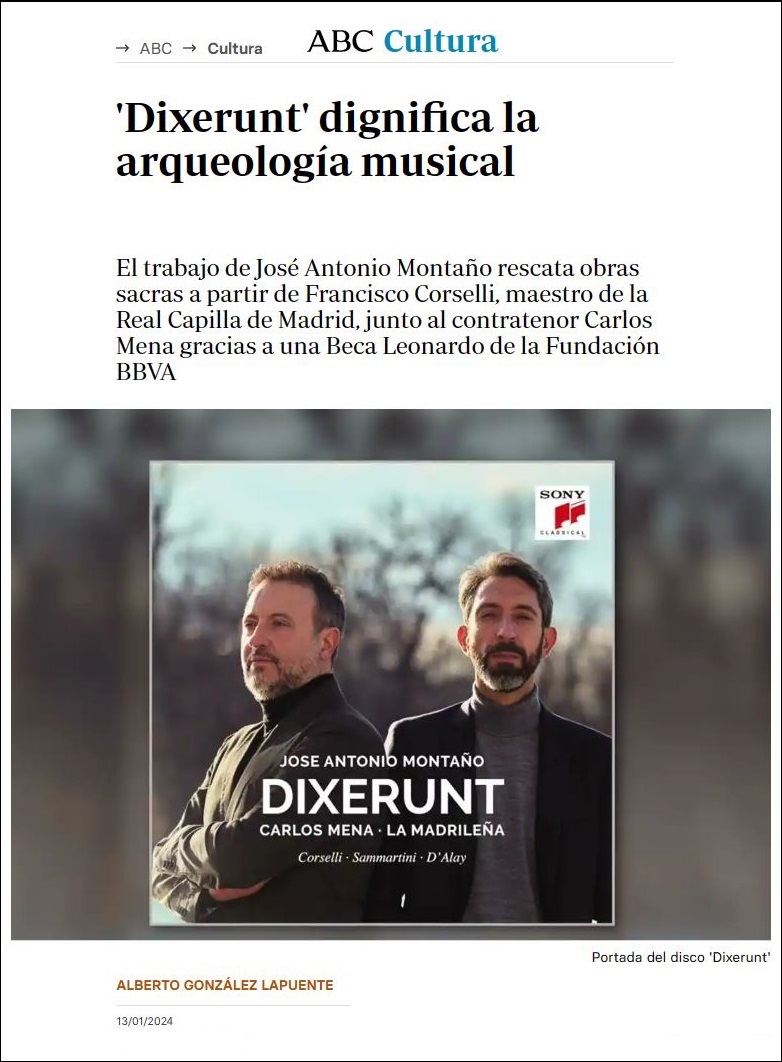 El trabajo de José Antonio Montaño rescata obras sacras a partir de Francisco Corselli, maestro de la Real Capilla de Madrid, junto al contratenor Carlos Mena gracias a una Beca Leonardo de la Fundación BBVA
El trabajo de José Antonio Montaño rescata obras sacras a partir de Francisco Corselli, maestro de la Real Capilla de Madrid, junto al contratenor Carlos Mena gracias a una Beca Leonardo de la Fundación BBVA
CONTRAPUNTO. FUNDACIÓN BBVA
Programa – Obras de Giovanni Battista Sammartini, Francesco Corselli, Mauro D’Alay y Domenico Scarlatti
Intérpretes – Carlos Mena, La Madrileña
Director – José Antonio Montaño
Lugar – Palacio del Marqués de Salamanca, Madrid
Fecha – 12/01/2024
Una de las quejas más habituales del mundo musical es la falta de promoción que tienen los proyectos singulares. Ahí está el compositor que recibe en encargo de una obra que se interpreta una sola vez y se olvida; el intérprete que defiende un repertorio distintivo que se perdió por simple dejadez; el editor que rebusca, publica y apenas y apenas vende; y hasta el investigador que analiza músicas que lo merecen y cuya supervivencia se limita a un artículo académico.
La severidad del mercado es tan formidable que a la avalancha de propuestas y a su aparente dinamismo se une el agotamiento general, redundando en lo tópico de muchas programaciones, en lo manido de tantos propósitos y en la inmediatez de numerosas realizaciones. Por supuesto, hay vida más allá de lo evidente.
Lo ejemplifica «Dixerunt», uno de los varios y ya muy importantes esfuerzos que se han hecho en las últimas décadas por valorar en su exacta dimensión la música española del siglo XVIII, es decir aquella que surge tras la llegada a España del primer Borbón, Felipe V, en 1700, y el incendio del Alcázar madrileño en la Nochebuena de 1734, lo que implicó la pérdida de su archivo musical con documentos acumulados desde la Edad Media. «Dixerunt» parte del empeño de José Antonio Montaño en rescatar obras sacras para alto y en Latín a partir de Francesco Corselli, maestro de la Real Capilla de Madrid. Una vez destruido el Alcázar, Corselli y José de Nebra fueron los artífices y promotores de la regeneración del repertorio musical acorde a una actualización de la música italiana en una corte de raigambre francesa.
La conjunción de elementos, con el añadido del factor español, es tan fascinante como inaudita y polémica. No hace falta retroceder demasiado en el tiempo para leer que la llegada de los italianos supuso el remate del «arte nacional ya muy debilitado». Contra la falsa españolidad y la ignorancia han trabajado los historiadores que han facilitado una imagen más veraz de aquella monarquía, como lo hacen ahora los músicos que permiten el acceso a un repertorio necesario para el encuadre de la historia cultural española de la época, con sus tensiones y sus evidentes grandezas.
Ese, sin duda, es el propósito final de «Dixerunt», demostración asimismo de que existe un camino para el rescate histórico. La propuesta de Montaño nace con el apoyo de una Beca Leonardo que la Fundación BBVA ofrece a creadores e intérpretes en su categoría de música y ópera, y con ella llegó la investigación, la posibilidad de colocar las viejas partituras en una edición accesible y la grabación del programa. El registro incluye obras de Corselli, del milanés Giovanni Battista Sammartini, propuesto por aquel como proveedor de repertorio para la corte, y de Mauro D’Alay, el violinista favorito de la reina Isabel de Farnesio. Montaño dirige a su orquesta barroca La Madrileña. Y junto a ellos está el contratenor Carlos Mena, un fiador indiscutible de la música española pues siempre hace creíble lo que ofrece. La escucha del disco así lo revela y aún lo ha hecho la interpretación en directo que la Fundación BBVA, dispuesta a recomponer la asimetría del mercado, acaba de incluir en la programación de su temporada con sede del Palacio del Marqués de Salamanca en Madrid, no por casualidad denominada Contrapunto. Se pueden considerar muchos aspectos en un proceso que desde la idea se abra a varios frentes, incluyendo la posibilidad de integrar músicos españoles de tanta calidad y especializados en el repertorio.
Aunque nada es ,más gratificante que el estricto descubrimiento de la dimensión sonora de un espacio histórico tan poderosamente sugerente.
ABC Cultura – Alberto González Lapuente – 13-01-2024
Radio Nacional de España. José Antonio Montaño es entrevistado en «Sinfonía de la mañana» 02-11-2023
El director de orquesta José Antonio Montaño es entrevistado por Martín Llade y Clara Corrales en el programa Sinfonía de la mañana de Radio Clásica de Radio Nacional de España a propósito de su último proyecto discográfico, Dixerunt, de Sony Classical, en el que dirige a La Madrileña y al contratenor Carlos Mena con obras de Corselli, Sammartini y D´Alay, algunas de ellas en su primera grabación mundial.
www.rtve.es/play/audios/Montaño
Il giornale della musica – Dixerunt. Due compositori italiani al servizio della Cappella Reale di Spagna nel Settecento
-ITALIANO-
La Madrileña è un orchestra che utilizza strumenti storici fondata da José Antonio Montaño, e il suo nome deriva dalla zarzuela basata su un’opera buffa di Vicente Martín y Soler.
Nel suo secondo disco recentemente pubblicato con il titolo Dixerunt l’orchestra esegue musiche conservate nei manoscritti dell’archivio del Palazzo Reale di Madrid, nella Biblioteca del Land della Sassonia e nel Fonds Blancheton della Biblioteca del Conservatorio di Parigi che fino ad oggi erano inedite. Si tratta di composizioni di tre autori, Francesco Corselli, Mauro D’Alay e Giovanni Battista Sammartini, i primi due attivi al servizio della corte spagnola.
Nel programma del disco risalta la figura di Corselli, nato a Piacenza all’inizio del XVIII secolo da genitori francesi, che dopo essere stato maestro di cappella a Parma si trasferì a Madrid nel 1734 dove dopo pochi anni divenne maestro della Cappella Reale grazie alla protezione di Isabella Farnese, consorte di Filippo V. Corselli che era cantante, oltre che clavicembalista e violinista, compose una grande quantità di opere, in particolare di musica sacra. Tra queste Montaño ha scelto due lamentazioni della Settimana Santa, due antifone mariane e un responsorio, oltre a un Concertino a 4.
Anche il Concerto per due violini in Re minore di Mauro D’Alay è stato registrato per la prima volta e si tratta di una delle composizioni del violinista nato a Parma e arrivato in Spagna al seguito di Isabella Farnese. Il quadro delle musiche inedite studiate e trascritte da José Antonio Montaño si completa con un concertino a 4 di Sammartini, e in questa intervista il direttore dell’orchestra La Madrileña parla in special modo di Corselli con un senso di hermandade (fratellanza) e cariño (affetto), data la particolare importanza del compositore italiano nella storia della musica iberica.
Il Giornale della Musica – 8 Novembre 2023 – Paolo Scarnecchia
-ESPAÑOL-
La Madrileña es una orquesta que utiliza instrumentos históricos fundada por José Antonio Montaño, cuyo nombre proviene de la zarzuela basada en una ópera bufa de Vicente Martín y Soler.
En su segundo disco recientemente publicado con el título Dixerunt, la orquesta interpreta música conservada en los manuscritos del archivo del Palacio Real de Madrid, en la Biblioteca Nacional de Sajonia y en los Fondos Blancheton de la Biblioteca del Conservatorio de París que hasta ahora eran inéditos. Se trata de composiciones de tres autores, Francesco Corselli, Mauro D’Alay y Giovanni Battista Sammartini, los dos primeros activos al servicio de la corte española.
En el programa del disco destaca la figura de Corselli, nacido en Piacenza a principios del siglo XVIII de padres franceses, que tras haber sido maestro de capilla en Parma se trasladó a Madrid en 1734 donde al cabo de unos años se convirtió en maestro de la Capilla Real gracias bajo la protección de Isabel de Farnesio, esposa de Felipe V. Corselli, que era cantante, además de clavecinista y violinista, compuso una gran cantidad de obras, en particular música sacra. De ellas Montaño eligió dos Lamentaciones para Semana Santa, dos Antífonas Marianas y un Responsorio, además de un Concertino a 4.
También ha sido grabado por primera vez el Concierto para dos violines en Re menor de Mauro D’Alay. Se trata de una de las composiciones del violinista nacido en Parma y que llegó a España siguiendo a Isabel Farnesio. El compendio de música inédita estudiada y transcrita por José Antonio Montaño se completa con un Concertino a 4 de Sammartini. En esta entrevista el director de la orquesta madrileña habla en particular de Corselli con sentido de hermandad y cariño, dada la especial importancia del compositor italiano en la historia de la música ibérica.
Il Giornale della Musica – 8 Novembre 2023 – Paolo Scarnecchia
Avvenire.it – Carlos Mena canta lo spirito della Spagna del Settecento
Carlos Mena canta lo spirito della Spagna del Settecento
Dixerunt
Carlos Mena
La Madrileña
José Antonio Montaño
Sony Classical
Sembra cucito perfettamente su misura su di lui, sulle sue qualità di interprete, sulle sue doti canore e sul timbro adamantino della sua voce: il disco intitolato Dixerunt che vede Carlos Mena protagonista assoluto di una raccolta di brevi ma intense pagine sacre che riportano alla luce l’arte e la spiritualità nella penisola iberica del Settecento. Diretto da José Antonio Montaño (che ha anche curato l’edizione critica delle opere selezionate) e accompagnato dall’ensemble strumentale La Madrileña, il controtenore spagnolo si addentra tra le nuances infinite di un repertorio davvero ricco di fascino e di emozioni. Al centro del lavoro si staglia la figura di Francesco Corselli (1705-1778), all’anagrafe Francisco Courcelle, nato a Piacenza da padre francese, che ricoprì la carica di Maestro della Cappella Reale di Madrid per oltre quarant’anni, fra il 1737 e l’anno della sua morte. Dopo gli esordi presso la Corte del Ducato di Parma, dove fu maestro di musica dell’infante Carlo di Borbone, nel 1732 si è appunto trasferito nella città spagnola e da allora ha svolto un ruolo di primo piano nella vita musicale del tempo, in un periodo in cui nella capitale del Regno brillavano gli astri di artisti del calibro del celebre cantore Carlo Broschi, in arte Farinelli. Mena si cimenta in alcune prime registrazioni assolute che contemplano un’Ave Regina, il Responsorio a Santa Cecilia e due toccanti Lamentazioni di Geremia, tradizionalmente intonate durante il Triduo Pasquale: semplicemente splendida è la Segunda de Miércoles Santo che sembra quasi assecondare un ritmo cullante di ninna-nanna, a cui fa seguito una trascinante versione del Regina Cæli, esemplare compendio in cui una brillante scrittura strumentale si sposa con l’espressività di linee vocali ad alto virtuosismo. La cifra distintiva di un autore che, come sostiene Montaño, «unisce due mondi musicali fondamentali per l’Europa, facendo incontrare la tradizione italiana con l’imponente eredità spagnola del Rinascimento».
Avvenire.it – 22 Ottobre 2023 – Andrea Milanesi
-ESPAÑOL-
Carlos Mena canta el espíritu de la España del siglo XVIII
Dixerunt
Carlos Mena
La Madrileña
José Antonio Montaño
Sony Classical
Parece perfectamente adaptado a él, a sus cualidades de intérprete, a su talento para el canto y al timbre diamantino de su voz: el disco titulado Dixerunt que ve a Carlos Mena como protagonista absoluto de una colección de breves pero intensas páginas sacras que traen la luz del arte y la espiritualidad en la península ibérica del siglo XVIII. Dirigido por José Antonio Montaño (que también realizó la edición crítica de las obras seleccionadas) y acompañado por el conjunto instrumental La Madrileña, el contratenor español profundiza en los infinitos matices de un repertorio verdaderamente rico en encanto y emoción. En el centro de la obra destaca la figura de Francesco Corselli (1705-1778), nacido Francisco Courcelle, nacido en Piacenza de padre francés, que ocupó el cargo de Maestro de la Capilla Real de Madrid durante más de cuarenta años, entre 1737 y el año de su muerte. Tras su debut en la Corte del Ducado de Parma, donde fue maestro de música del infante Carlos de Borbón, en 1732 se trasladó a la ciudad española y desde entonces ha tenido un papel protagonista en la vida musical de la época, en un período en el que las estrellas de artistas del calibre del célebre cantante Carlo Broschi, conocido como Farinelli, brillaron en la capital del Reino. Mena acomete primeras grabaciones que incluyen un Ave Regina, el Responsorio a Santa Cecilia y dos conmovedoras Lamentaciones de Jeremías, tradicionalmente cantadas durante el Triduo Pascual: la Segunda Lamentación de Miércoles Santo es sencillamente espléndida y casi parece seguir un ritmo arrullador de canción de cuna, al que sigue una apasionante versión del Regina Cæli, un compendio ejemplar en el que se combina una brillante escritura instrumental con la expresividad de unas líneas vocales de gran virtuosismo. El rasgo distintivo de un autor que, como afirma Montaño, «une dos mundos musicales fundamentales para Europa, uniendo la tradición italiana con el imponente legado español del Renacimiento».
Avvenire.it – 22 Ottobre 2023 – Andrea Milanesi
Le Parnasse Musical – Dixerunt. Jose Antonio Montano, Carlos Mena, La Madrilena.
Appréciation: Superbe*****
Dixerunt
Carlos Mena
La Madrileña
José Antonio Montaño
Sony Classical
Isabel de Farnesio (1692-1766) fut reine d’Espagne de 1714 à1746. Née en Italie, elle épousa le roi Philippe V et s’installa à Madrid. Personnalité très cultivée, elle invita plusieurs artistes et compositeurs italiens à la cour royale. C’est là que se présente un certain Francesco Corselli, né Courcelles, qui composa de nombreuses pièces liturgiques et instrumentales. Suite à un feu qui dévasta la Chapelle Royale en 1734, il dut fournir un grand volume d’oeuvres sacrées.
Jusqu’à présent Corselli a été peu enregistré au disque. On découvre dans cette production madrilène quelques-unes de ses pièces en première mondiale. La qualité de sa musique est particulièrement riche. Et bien qu’elle paraisse à première vue comme de la musique baroque, elle figure par son style à la période post-vivaldienne et rejoint, par exemple, celle de Pergolesi. Les formes sont plus libres, ouvertes sur l’expression, comme en fait foi ces émouvantes Lamentations que l’on entend ici pour la première fois. Son Concertino a 4 est d’une écriture contrapunctique étonnante pour cette époque, d’une belle invention qui rappelle la sonata da chiesa de Corelli.
L’art vocal de Carlos Mena fait sensation par une belle variété de timbres, de l’aigue de sa tessiture jusqu’aux fréquences graves digne d’un contralto féminin. Sa projection de haute-contre rappelle la luminosité du regretté James Bowman qui est décédé en début d’année. Il est accompagné de manière admirable par les cordes expressives de l’ensemble Madrilena. Son chef José Antonio Montaño les dirige avec toute la sensibilité voulue ainsi que par un lyrisme d’une grande souplesse.
En complément, quelques oeuvres de deux autres italiens qui furent de près ou de loin associés à la cour de la Reine Isabel, G.B. Sammartini précurseur de la symphonie classique et Mauro d’Alay, virtuose du violon qui signe un double concerto digne de Vivaldi. Superbe album.Además, se exponen algunas obras de otros dos italianos que estuvieron directa o indirectamente relacionados con la corte de la reina Isabel, G. B. Sammartini, precursor de la sinfonía clásica, y Mauro d’Alay, virtuoso del violín que creó un doble concierto digno de Vivaldi. Magnífico álbum.
LeParnasseMusical – 22 octobre 2023 – René François Auclair
-ESPAÑOL-
Calificación: Excelente*****
Dixerunt
Carlos Mena
El madrileño
José Antonio Montaño
Sony Classical
Isabel de Farnesio (1692-1766) fue Reina de España desde 1714 hasta 1746. Nacida en Italia, se casó con el rey Felipe V y se instaló en Madrid. Personalidad muy culta, invitó a varios artistas y compositores italianos a la corte real. Aquí aparece un tal Francesco Corselli, nacido en Courcelles, que compuso numerosas piezas litúrgicas e instrumentales. Tras un incendio que devastó la Capilla Real en 1734, tuvo que aportar un gran volumen de obras sacras.
Hasta ahora, Corselli ha sido poco registrado. En esta producción madrileña descubrimos algunas de sus obras en estreno mundial. La calidad de su música es particularmente rica. Y aunque a primera vista parezca música barroca, su estilo pertenece al periodo post-vivaldiano y se suma, por ejemplo, al de Pergolesi. Las formas son más libres, abiertas a la expresión, como lo demuestran estas conmovedoras Lamentaciones que escuchamos aquí por primera vez. Su Concertino a 4 es una escritura contrapuntística sorprendente para esa época, una hermosa invención que recuerda a la sonata da chiesa de Corelli.
El arte vocal de Carlos Mena causa sensación con una hermosa variedad tímbrica, desde los agudos de su rango hasta las bajas frecuencias dignas de una contralto femenina. Su proyección de alto contraste recuerda la luminosidad del fallecido James Bowman, fallecido a principios de año. Está admirablemente acompañado por las expresivas cuerdas del conjunto madrileño. Su director José Antonio Montaño los dirige con toda la sensibilidad deseada además de un lirismo de gran flexibilidad.
Además, se exponen algunas obras de otros dos italianos que estuvieron directa o indirectamente relacionados con la corte de la reina Isabel, G. B. Sammartini, precursor de la sinfonía clásica, y Mauro d’Alay, virtuoso del violín que creó un doble concierto digno de Vivaldi. Magnífico álbum.
LeParnasseMusical – 22 octobre 2023 – René François Auclair
Classical Voice – Quattro stelle ****
ENSEMBLE La Madrileña
DIRETTORE José Antonio Montaño
CONTROTENORE Carlos Mena
Sony Classical 2023
****
-ITALIANO-
L’immaginario costringe la «musica spagnola» in esotismi flamencoidi colle nacchere usate dappertutto come il #pistacchiodibronte, eppure il Settecento vide popolare quel contesto da musici, in gran parte di provenienza italiana, le cui qualità formali e stilistiche sono oggetto di riscoperta da decenni (basti citare l’operato di Antonio Florio e dei suoi ensemble dediti al repertorio napoletano).
José Antonio Montaño impagina invece un’antologia strumentale e vocale con pagine di Giovanni Battista Sammartini (la bellissima Sinfonia in Sol maggiore, memore di una Milano non più spagnola, e un concerto a quattro), Francesco Corselli (piacentino alla corte borbonica di Madrid) e Maurino D’Alay (parmigiano a sua volta di stanza in Spagna per qualche tempo).
L’intento documentario è concentrato sulla figura di Corselli, i cui brani vocali e strumentali, cantati da Carlos Mena (uno dei pochi controtenori intonati), denunciano mano sicura e buona pratica dei linguaggi comuni coi quali il Settecento musicale faceva circolare i propri messaggi.
Valutando questi brani in base al tasso di innovazione si commette un’ingiustizia, viceversa considerando l’elevata qualità media di quell’epoca con l’infima qualità media di altre epoche, gli interrogativi etici ed estetici fioccano a profusione.
Classic Voice – Settembre 2023 – Carlo Fiore
-ESPAÑOL-
El imaginario lleva a la «música española» a exotismos flamencos con castañuelas utilizadas en todas partes como «pistachiodibronte», sin embargo, el siglo XVIII vio ese contexto popularizado por músicos, en su mayoría de origen italiano, cuyas cualidades formales y estilísticas han sido objeto de redescubrimiento durante décadas (basta mencionar la obra de Antonio Florio y sus conjuntos dedicados al repertorio napolitano).
José Antonio Montaño crea en cambio una antología instrumental y vocal con páginas de Giovanni Battista Sammartini (la bella Sinfonía en sol mayor, que recuerda a un Milán que ya no es español, y un concierto para cuatro), Francesco Corselli (de Piacenza en la corte borbónica en Madrid) y Maurino D’Alay (de Parma trasladado a España por algún tiempo).
La intención documental se centra en la figura de Corselli, cuyas piezas vocales e instrumentales, cantadas por Carlos Mena (uno de los pocos contratenores afinados), enuncian con mano firme y buen hacer los lenguajes comunes con los que la música del siglo XVIII hacía circular sus mensajes.
Se comete una injusticia con estas piezas si solo se las evalúa por innovadoras, al contrario, considerando la alta calidad media de esa época con la ínfima calidad media de otros periodos, las cuestiones éticas y estéticas surgen profusamente.
Classic Voice – Septiembre 2023 – Carlo Fiore
Le Salon Musical – José Antonio Montaño: “Dixerunt” e non solo
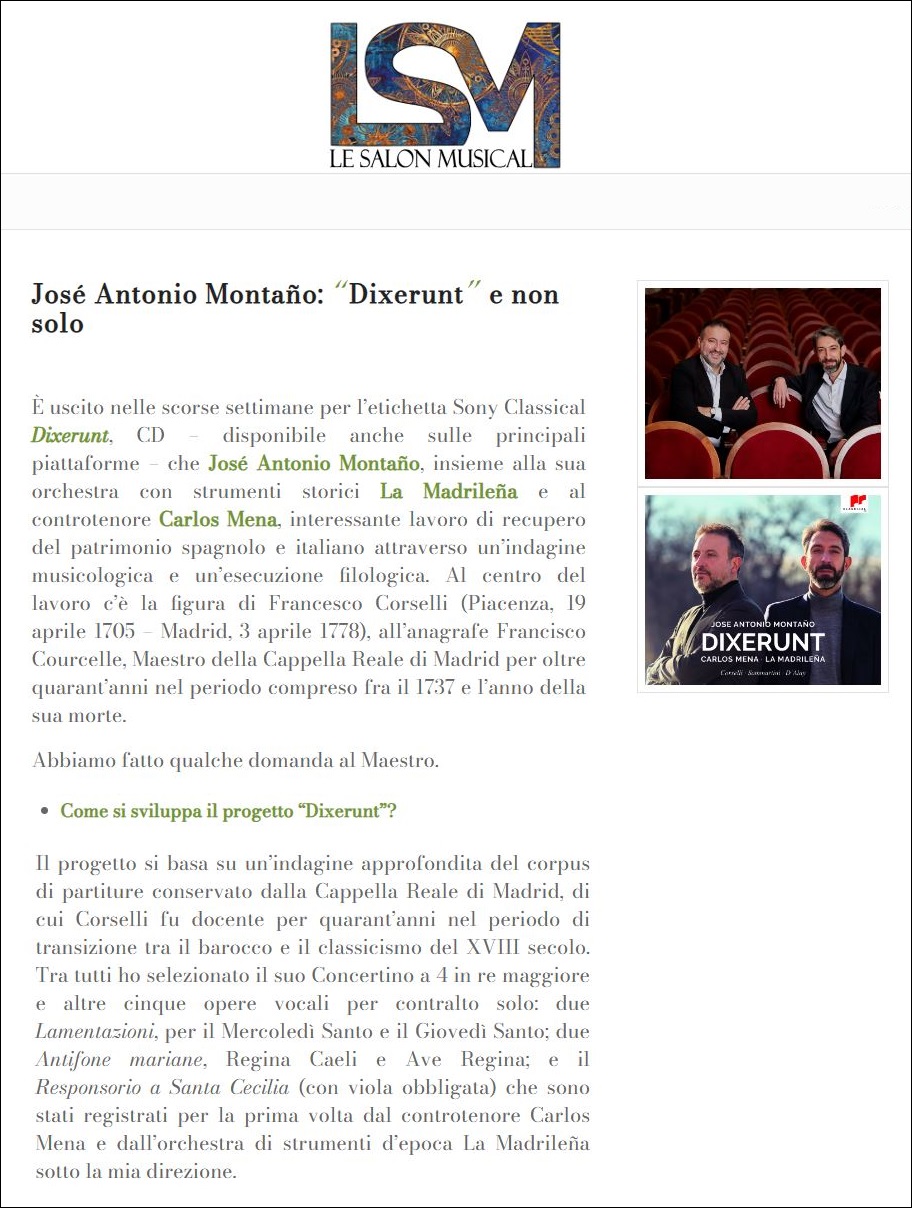 È uscito nelle scorse settimane per l’etichetta Sony Classical Dixerunt, CD – disponibile anche sulle principali piattaforme – che José Antonio Montaño, insieme alla sua orchestra con strumenti storici La Madrileña e al controtenore Carlos Mena, interessante lavoro di recupero del patrimonio spagnolo e italiano attraverso un’indagine musicologica e un’esecuzione filologica. Al centro del lavoro c’è la figura di Francesco Corselli (Piacenza, 19 aprile 1705 – Madrid, 3 aprile 1778), all’anagrafe Francisco Courcelle, Maestro della Cappella Reale di Madrid per oltre quarant’anni nel periodo compreso fra il 1737 e l’anno della sua morte.
È uscito nelle scorse settimane per l’etichetta Sony Classical Dixerunt, CD – disponibile anche sulle principali piattaforme – che José Antonio Montaño, insieme alla sua orchestra con strumenti storici La Madrileña e al controtenore Carlos Mena, interessante lavoro di recupero del patrimonio spagnolo e italiano attraverso un’indagine musicologica e un’esecuzione filologica. Al centro del lavoro c’è la figura di Francesco Corselli (Piacenza, 19 aprile 1705 – Madrid, 3 aprile 1778), all’anagrafe Francisco Courcelle, Maestro della Cappella Reale di Madrid per oltre quarant’anni nel periodo compreso fra il 1737 e l’anno della sua morte.
Abbiamo fatto qualche domanda al Maestro.
Come si sviluppa il progetto “Dixerunt”?
Il progetto si basa su un’indagine approfondita del corpus di partiture conservato dalla Cappella Reale di Madrid, di cui Corselli fu docente per quarant’anni nel periodo di transizione tra il barocco e il classicismo del XVIII secolo. Tra tutti ho selezionato il suo Concertino a 4 in re maggiore e altre cinque opere vocali per contralto solo: due Lamentazioni, per il Mercoledì Santo e il Giovedì Santo; due Antifone mariane, Regina Caeli e Ave Regina; e il Responsorio a Santa Cecilia (con viola obbligata) che sono stati registrati per la prima volta dal controtenore Carlos Mena e dall’orchestra di strumenti d’epoca La Madrileña sotto la mia direzione.
Dixerunt include anche opere strumentali di altri due compositori italiani contemporanei di Corselli. Abbiamo registrato la famosa Sinfonia J-C39 di Giovanni Battista Sammartini così come il suo Concertino a 4 stromenti, opera anch’essa recuperata nel progetto. Completa l’album il Concerto per 2 violini in re minore di Mauro D’Alay, grande violinista e compositore originario di Parma, che ebbe un rapporto importante sia con Corselli che con la corte spagnola. Maxim Kosinov e Ignacio Ramal sono i violinisti solisti incaricati di registrarlo.
Il progetto è stato premiato con la prestigiosa Borsa di Studio Leonardo della Fondazione BBVA rivolta a ricercatori e creatori culturali, che ha permesso di intraprendere e completare Dixerunt con la registrazione avvenuta nella magnifica sala della Reale Accademia di Belle Arti di San Fernando a Madrid nel gennaio 2022 e la sua recente pubblicazione con l’etichetta Sony Classical.
Full interview in Italian/Spanish – Entrevista completa en italiano/español
Le Salon Musical-21-09-2023-Alessandro Cammarano
El Cultural – Crítica DIXERUNT por Arturo Reverter
José Antonio Montaño y Carlos Mena recuperan al maestro Corselli en ‘Dixerunt’
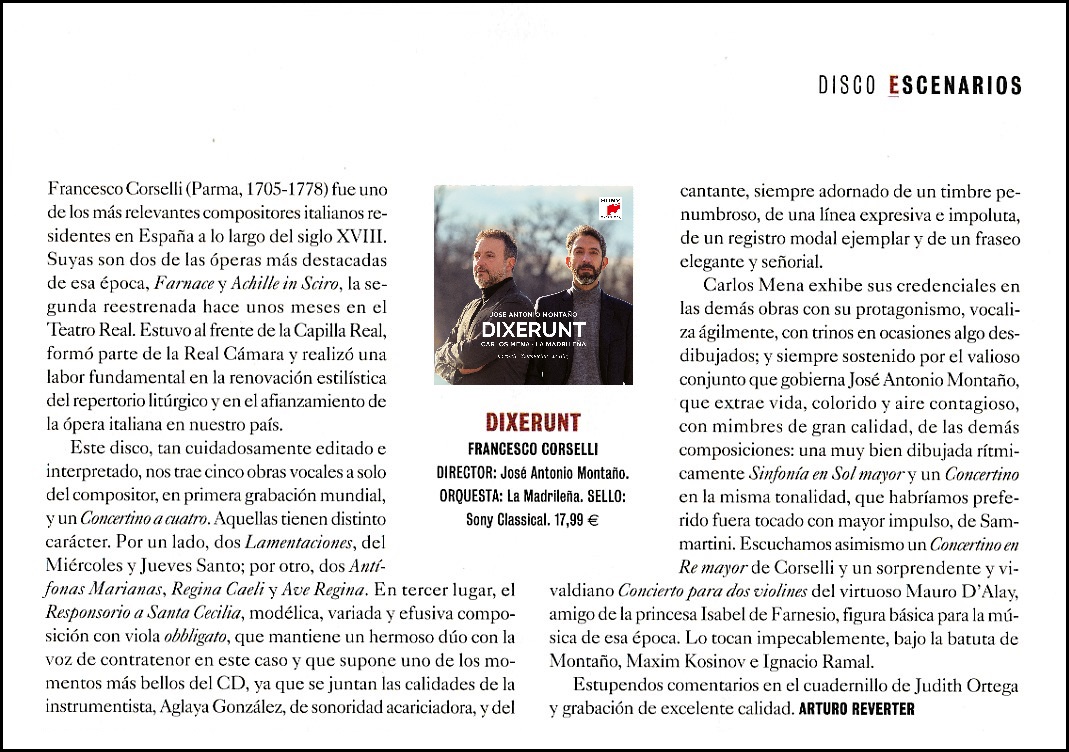 El director musical y el contratenor debutan con el sello Sony Classical con un álbum que rescata el patrimonio del compositor italo-español.
El director musical y el contratenor debutan con el sello Sony Classical con un álbum que rescata el patrimonio del compositor italo-español.
Francesco Corselli (Parma, 1705-1778) fue uno de los más relevantes compositores italianos residentes en España a lo largo del siglo XVIII. Suyas son dos de las óperas más destacadas de esa época, Farnace y Achille in Sciro, la segunda estrenada hace unos meses en el Teatro Real. Estuvo al frente de la Capilla Real, formó parte de la Real Cámara y realizó una labor fundamental en la renovación estilística del repertorio litúrgico y en el afianzamiento de la ópera italiana en nuestro país.
Este disco, tan cuidadosamente editado e interpretado, nos trae cinco obras vocales a solo del compositor, en primera grabación mundial, y un Concertino a cuatro. Aquellas tienen distinto carácter. Por un lado, dos Lamentaciones, del Miércoles y Jueves Santo; por otro, dos Antífonas Marianas, Regina Caeli y Ave Regina. En tercer lugar, el Responsorio a Santa Cecilia, modélica, variada y efusiva composición con viola obbligato, que mantiene un hermoso dúo con la voz de contratenor en este caso y que supone uno de los momentos más bellos del CD, ya que se juntan las calidades de la instrumentista, Aglaya González, de sonoridad acariciadora, y del cantante, siempre adornado de un timbre penumbroso, de una línea expresiva e impoluta, de un registro modal ejemplar y de un fraseo elegante y señorial.
Carlos Mena exhibe sus credenciales en las demás obras con su protagonismo, vocaliza ágilmente, con trinos en ocasiones algo desdibujados; y siempre sostenido por el valioso conjunto que gobierna José Antonio Montaño, que extrae vida, colorido y aire contagioso, con mimbres de gran calidad, de las demás composiciones: una muy bien dibujada rítmicamente Sinfonía en Sol mayor y un Concertino en la misma tonalidad, que habríamos preferido fuera tocado con mayor impulso, de Sammartini. Escuchamos asimismo un Concertino en Re mayor de Corselli y un sorprendente y vivaldiano Concierto para dos violines del virtuoso Mauro D’Alay, amigo de la princesa Isabel de Farnesio, figura básica para la música de esa época. Lo tocan impecablemente, bajo la batuta de Montaño, Maxim Kosinov e Ignacio Ramal.
Estupendos comentarios en el cuadernillo de Judith Ortega y grabación de excelente calidad.
El Cultural 08-09-2023 Arturo Reverter
www.elespanol.com/el-cultural/
MUSICPAPER – Crítica DIXERUNT por Alessandro Costanzo
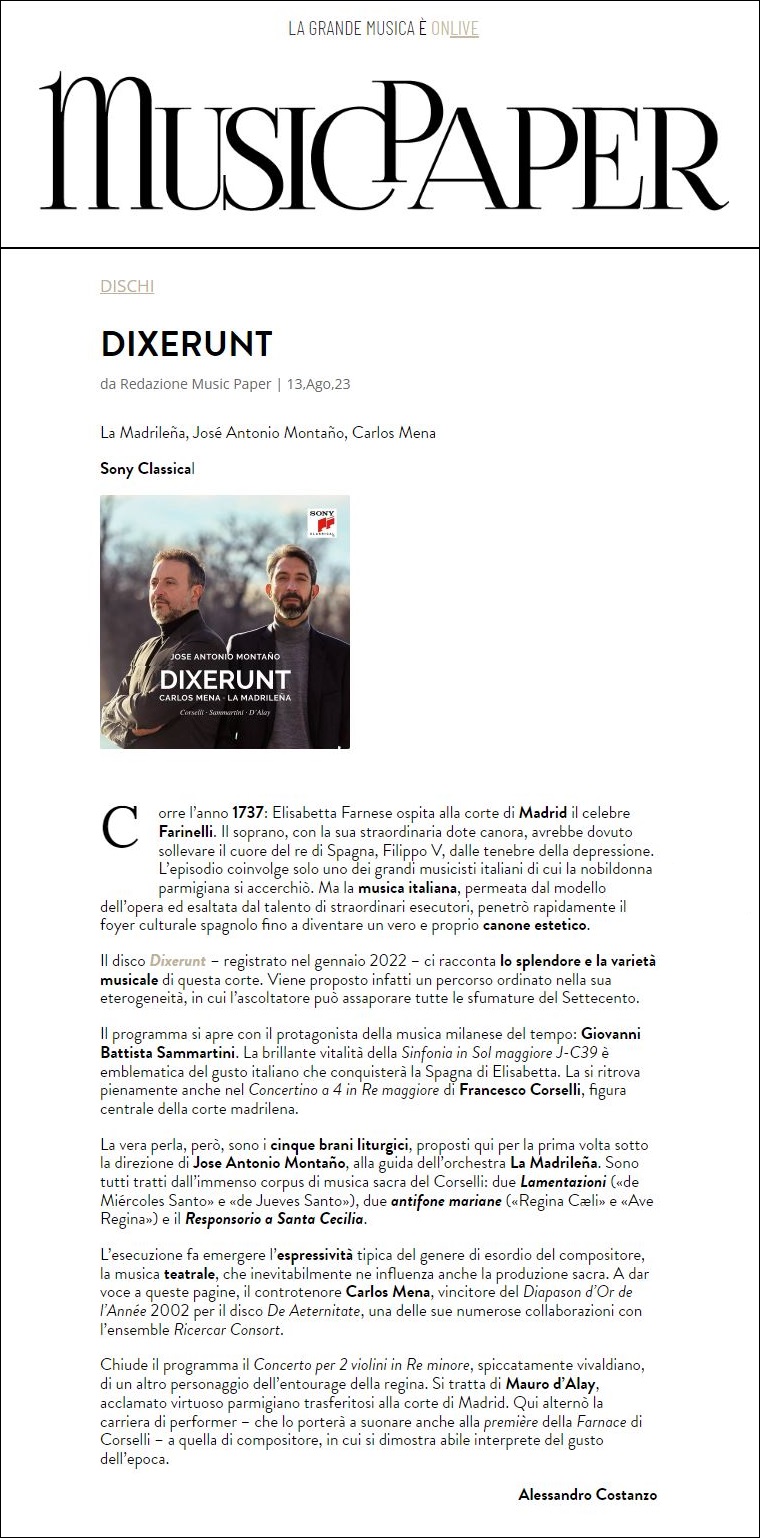 DIXERUNT
DIXERUNT
da Redazione Music Paper | 13, Ago,23
La Madrileña, José Antonio Montaño, Carlos Mena
Sony Classical
Corre l’anno 1737: Elisabetta Farnese ospita alla corte di Madrid il celebre Farinelli. Il soprano, con la sua straordinaria dote canora, avrebbe dovuto sollevare il cuore del re di Spagna, Filippo V, dalle tenebre della depressione. L’episodio coinvolge solo uno dei grandi musicisti italiani di cui la nobildonna parmigiana si accerchiò. Ma la musica italiana, permeata dal modello dell’opera ed esaltata dal talento di straordinari esecutori, penetrò rapidamente il foyer culturale spagnolo fino a diventare un vero e proprio canone estetico.
Il disco Dixerunt – registrato nel gennaio 2022 – ci racconta lo splendore e la varietà musicale di questa corte. Viene proposto infatti un percorso ordinato nella sua eterogeneità, in cui l’ascoltatore può assaporare tutte le sfumature del Settecento.
Il programma si apre con il protagonista della musica milanese del tempo: Giovanni Battista Sammartini. La brillante vitalità della Sinfonia in Sol maggiore J-C39 è emblematica del gusto italiano che conquisterà la Spagna di Elisabetta. La si ritrova pienamente anche nel Concertino a 4 in Re maggiore di Francesco Corselli, figura centrale della corte madrilena.
La vera perla, però, sono i cinque brani liturgici, proposti qui per la prima volta sotto la direzione di Jose Antonio Montaño, alla guida dell’orchestra La Madrileña. Sono tutti tratti dall’immenso corpus di musica sacra del Corselli: due Lamentazioni («de Miércoles Santo» e «de Jueves Santo»), due antifone mariane («Regina Cæli» e «Ave Regina») e il Responsorio a Santa Cecilia.
L’esecuzione fa emergere l’espressività tipica del genere di esordio del compositore, la musica teatrale, che inevitabilmente ne influenza anche la produzione sacra. A dar voce a queste pagine, il controtenore Carlos Mena, vincitore del Diapason d’Or de l’Année 2002 per il disco De Aeternitate, una delle sue numerose collaborazioni con l’ensemble Ricercar Consort.
Chiude il programma il Concerto per 2 violini in Re minore, spiccatamente vivaldiano, di un altro personaggio dell’entourage della regina. Si tratta di Mauro d’Alay, acclamato virtuoso parmigiano trasferitosi alla corte di Madrid. Qui alternò la carriera di performer – che lo porterà a suonare anche alla première della Farnace di Corselli – a quella di compositore, in cui si dimostra abile interprete del gusto dell’epoca.
Musicpaper 13-08-2023-Alessandro Costanzo
Scherzo – Entrevista a José Antonio Montaño «La Música Antigua española necesita políticas culturales serias»
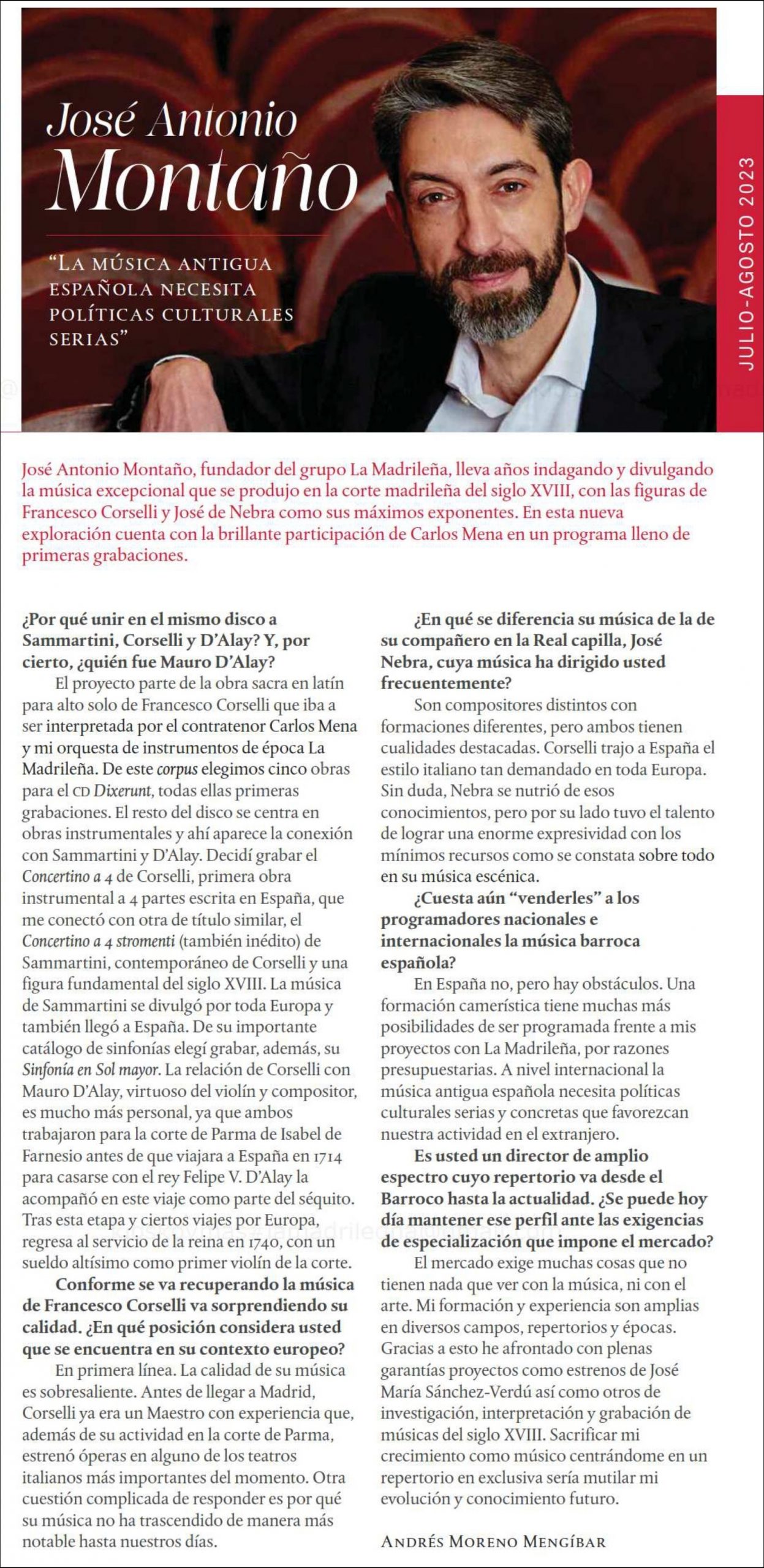 José Antonio Montaño, fundador del grupo La Madrileña, lleva años indagando y divulgando la música excepcional que se produjo en la corte madrileña del siglo XVIII, con las figuras de Francesco Corselli y José de Nebra como sus máximos exponentes. En esta nueva exploración cuenta con la brillante participación de Carlos Mena en un programa lleno de primeras grabaciones.
José Antonio Montaño, fundador del grupo La Madrileña, lleva años indagando y divulgando la música excepcional que se produjo en la corte madrileña del siglo XVIII, con las figuras de Francesco Corselli y José de Nebra como sus máximos exponentes. En esta nueva exploración cuenta con la brillante participación de Carlos Mena en un programa lleno de primeras grabaciones.
¿Por qué unir en el mismo disco a Sammartini, Corselli y D’Alay? Y, por cierto, ¿quién fue Mauro D’Alay?
El proyecto parte de la obra sacra en latín para alto solo de Francesco Corselli que iba a ser interpretada por el contratenor Carlos Mena y mi orquesta de instrumentos de época La Madrileña. De este corpus elegimos cinco obras para el CD Dixerunt, todas ellas primeras grabaciones. El resto del disco se centra en obras instrumentales y ahí aparece la conexión con Sammartini y D’Alay. Decidí grabar el Concertino a 4 de Corselli, primera obra instrumental a 4 partes escrita en España, que me conectó con otra de título similar, el Concertino a 4 stromenti (también inédito) de Sammartini, contemporáneo de Corselli y una figura fundamental del siglo XVIII. La música de Sammartini se divulgó por toda Europa y también llegó a España. De su importante catálogo de sinfonías elegí grabar, además, su Sinfonía en Sol mayor. La relación de Corselli con Mauro D’Alay, virtuoso del violín y compositor, es mucho más personal, ya que ambos trabajaron para la corte de Parma de Isabel de Farnesio antes de que viajara a España en 1714 para casarse con el rey Felipe V. D’Alay la acompañó en este viaje como parte del séquito. Tras esta etapa y ciertos viajes por Europa, regresa al servicio de la reina en 1740, con un sueldo altísimo como primer violín de la corte.
Conforme se va recuperando la música de Francesco Corselli va sorprendiendo su calidad. ¿En qué posición considera usted que se encuentra en su contexto europeo?
En primera línea. La calidad de su música es sobresaliente. Antes de llegar a Madrid, Corselli ya era un Maestro con experiencia que, además de su actividad en la corte de Parma, estrenó óperas en alguno de los teatros italianos más importantes del momento. Otra cuestión complicada de responder es por qué su música no ha trascendido de manera más notable hasta nuestros días.
¿En qué se diferencia su música de la de su compañero en la Real capilla, José Nebra, cuya música ha dirigido usted frecuentemente?
Son compositores distintos con formaciones diferentes, pero ambos tienen cualidades destacadas. Corselli trajo a España el estilo italiano tan demandado en toda Europa. Sin duda, Nebra se nutrió de esos conocimientos, pero por su lado tuvo el talento de lograr una enorme expresividad con los mínimos recursos como se constata sobre todo en su música escénica.
¿Cuesta aún “venderles” a los programadores nacionales e internacionales la música barroca española?
En España no, pero hay obstáculos. Una formación camerística tiene muchas más posibilidades de ser programada frente a mis proyectos con La Madrileña, por razones presupuestarias. A nivel internacional la música antigua española necesita políticas culturales serias y concretas que favorezcan nuestra actividad en el extranjero.
Es usted un director de amplio espectro cuyo repertorio va desde el Barroco hasta la actualidad. ¿Se puede hoy día mantener ese perfil ante las exigencias de especialización que impone el mercado?
El mercado exige muchas cosas que no tienen nada que ver con la música, ni con el arte. Mi formación y experiencia son amplias en diversos campos, repertorios y épocas. Gracias a esto he afrontado con plenas garantías proyectos como estrenos de José María Sánchez-Verdú así como otros de investigación, interpretación y grabación de músicas del siglo XVIII. Sacrificar mi crecimiento como músico centrándome en un repertorio en exclusiva sería mutilar mi evolución y conocimiento futuro.
Scherzo-1 Jul 2023-Andrés Moreno Mengíbar
Scherzo – Crítica DIXERUNT por Andrés Moreno Mengíbar
 Obras de Sammartini, Corselli y D’Alay. Carlos Mena, contratenor. La Madrileña. Director: José Antonio Montaño SONY CLASSICAL (1 CD)
Obras de Sammartini, Corselli y D’Alay. Carlos Mena, contratenor. La Madrileña. Director: José Antonio Montaño SONY CLASSICAL (1 CD)
La imagen tradicional de una España situada musicalmente hablando en la periferia europea, fuera de las corrientes estilísticas y anclada en la tradición, se va desvaneciendo a pasos agigantados. Sólo hacían falta investigaciones serias en los numerosos fondos documentales, que los intérpretes se interesasen por ese patrimonio y que los programadores mostrasen también sensibilidad y perspicacia para darlo a conocer al público, para que el panorama cambiase radicalmente. Así, por ejemplo, ha ocurrido con la Real Capilla merced a las investigaciones de personas como Begoña Lolo o Judith Ortega (que firma las notas de esta grabación). Torres, Nebra y Corselli pueden ser ya considerados compositores de una valía internacional.
Para la ocasión de este excelente disco se rescatan obras litúrgicas de Corselli (dos lamentaciones, Regina Coeli, Ave Regina, Responsorio a Santa Cecilia), además del Concertino a 4.
Carlos Mena está en el mejor momento de su carrera, plenamente dueño de todos los recursos de su voz, una voz de una belleza tímbrica excepcional, homogénea, sin saltos y con una naturalidad absoluta en el fraseo y en la transición entre registros. Su maestría a la hora de moldear las frases palabra a palabra alcanza cotas de excelencia en las lamentaciones, escritas de una forma libre, como un declamado melódico continuado que le sirven al cantante para explayarse a voluntad en acentos y dinámicas. En la obra dedicada a Santa Cecilia hay una parte obligada para viola en la que sobresale el sonido cálido de Aglaya González. Montaño aprovecha la sinfonía de Sammartini, el Concertino de Corselli y el Concierto para dos violines de Mauro D’Alay para llevar a La Madrileña a un altísimo nivel de prestaciones, con sonido empastado y brillante y gran atención a los contrastes expresivos.
Scherzo-1 Jul 2023-Andrés Moreno Mengíbar
www.scherzo.es/discos-excepcionales-de-julio-agosto-2023/
Scherzo – El CD DIXERUNT es galardonado por la revista Scherzo como disco excepcional de los meses julio-agosto 2023.
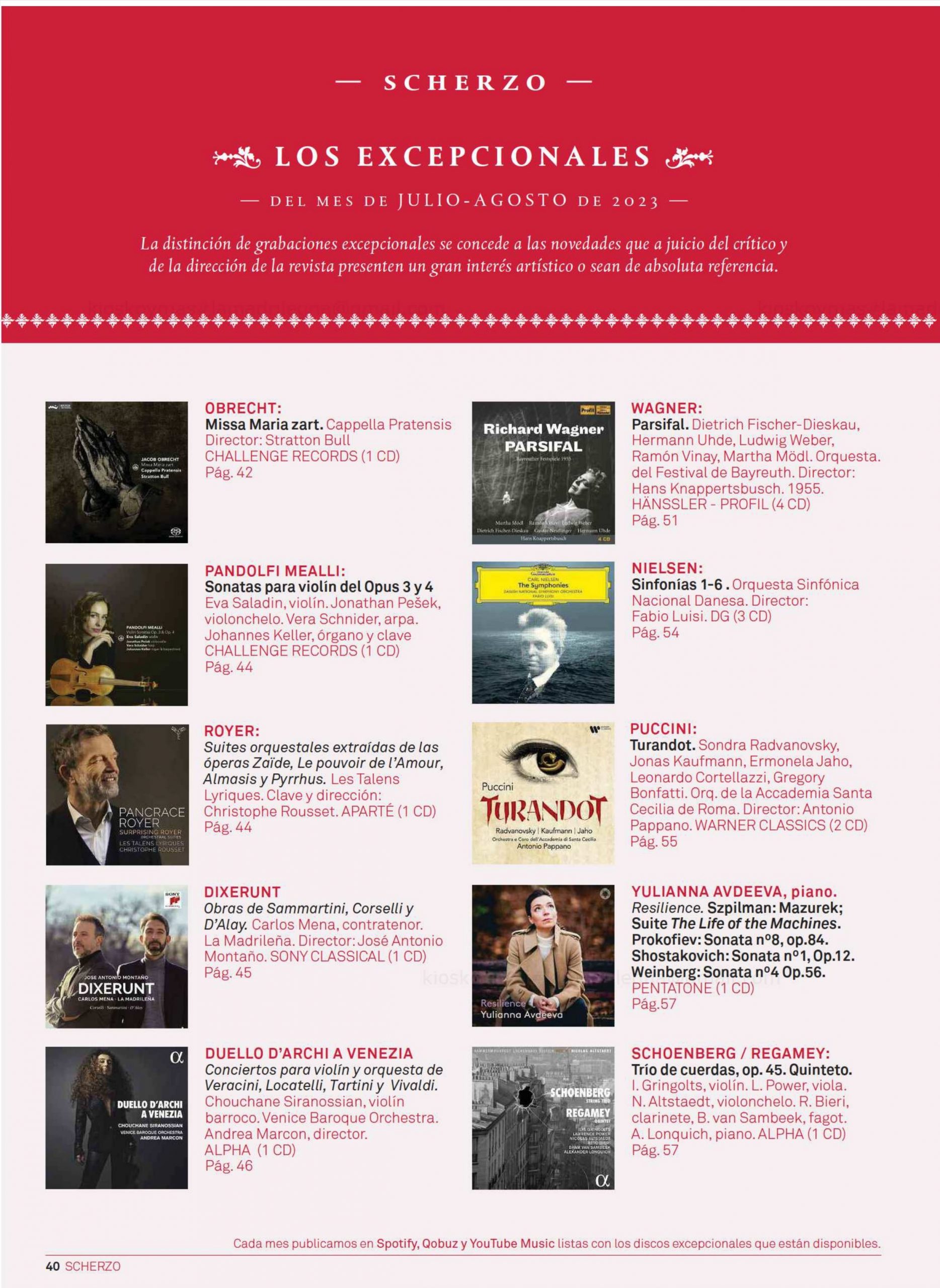 El nuevo trabajo discográfico de José Antonio Montaño y La Madrileña, acompañados por el contratenor Carlos Mena, es galardonado por la revista musical Scherzo como disco excepcional de los meses julio y agosto de 2023.
El nuevo trabajo discográfico de José Antonio Montaño y La Madrileña, acompañados por el contratenor Carlos Mena, es galardonado por la revista musical Scherzo como disco excepcional de los meses julio y agosto de 2023.
La distinción de grabaciones excepcionales se concede a las novedades que a juicio del crítico y de la dirección de la revista Scherzo presenten un gran interés artístico o sean de absoluta referencia.
DIXERUNT Sony Classical
Obras de Sammartini, Corselli y D’Alay
Carlos Mena, Contatenor
La Madrileña
Director: José Antonio Montaño
www.scherzo.es/discos-excepcionales-de-julio-agosto-2023/
Revista Melómano – Discos recomendados *****
DIXERUNT
La Madrileña
Carlos Mena, contratenor
José Antonio Montaño, director
Sony Classical 2023
*****
Carlos Mena es, sin ninguna duda, uno de los contratenores españoles más destacados, con una gran variedad de repertorios a sus espaldas. Profesor de canto histórico en la Schola Cantorum Basiliensis, según sus propias declaraciones, se encuentra en su momento vocal más interesante de su carrera musical y así lo demuestra en esta grabación del sello Sony Classical. Acompañado por el conjunto historicista La Madrileña, interpreta aquí música religiosa de Francesco Corselli, gran compositor del Barroco español y todavía demasiado olvidado en las grabaciones y salas de concierto. De hecho, todas las obras vocales incluidas en este álbum son primeras grabaciones mundiales.
Destaca la buena dicción y musicalidad de la voz, así como el buen acompañamiento orquestal, moldeando siempre las inflexiones interpretativas de Mena a favor del buen gusto musical. El bajo continuo elegido para las obras religiosas es el órgano en lugar del clave. Esta es una praxis interpretativa bastante común, aunque conviene destacar que no sería la única posible.
La grabación se complementa con obras instrumentales del mismo Corselli, así como de Giovanni Battista Sammartini, un compositor ya bastante conocido entre los amantes de la música barroca, con un cierto regusto del Preclasicismo.
Finalmente, el Concierto para dos violines en Re menor de Mauro D’Alay es todo un descubrimiento.en el buen sentido de la palabra, destacando un excelente diálogo entre los instrumentos solistas y la orquesta.
Es importante destacar el buen papel de José Antonio Montaño como director musical, con buena elección de tempi y estilo musical, tanto en la música sacra como en la profana. El librillo está bien documentado con informaciones concisas, muy claras y pedagógicas. Se agradece que aparezcan grabaciones como estas que nos permiten alejarnos de los típicos repertorios grabados cientos de veces. La música desconocida no tiene que ser de peor calidad; simplemente tenemos que abrir la mente a descubrir nuevas cosas.
Melómano Septiembre-2023 Ángel Villagrasa Pérez
Ritmo – Crítica DIXERUNT por Salustio Alvarado ****
La Madrileña
Carlos Mena, contratenor
José Antonio Montaño, director
Sony Classical 2023
****
La música española entre el Barroco y el Clasicismo, sigue estando en zona penumbrosa. Por esto hay que recibir con especial entusiasmo grabaciones como la presente, con varias primicias discográficas y que arroja luz sobre el panorama musical español durante los reinados de Felipe V y Fernando VI.
El núcleo del programa lo integran obras de Francesco Corselli (1705-1778), músico favorito de la reina Isabel de Farnesio, con dos Lamentaciones de Jeremías, dos himnos marianos Regina Caeli y Ave Regina, un responsorio a Santa Cecilia, con “obbligato” de viola, y un concertinoa 4 para cuerda.
Quizá pueda sorprender la presencia de dos obras del “abuelo de la sinfonía”, Giovanni Battista Sammartini (1700-1775), quien desarrolló su carrera artística sin moverse de Milán. Sin embargo sus obras fueron muy apreciadas y difundidas por toda Europa, sin que la Villa y Corte de Madrid fuera una excepción.
El disco concluye con un muy vivaldiano Concierto en re menor para dos violines de Mauro d’Alay (1687-1757), el compositor revelación de los últimos tiempos.
Sobresalientes versiones del contratenor Calos Mena y de la orquesta La Madrileña, bajo la dirección de José Antonio Montaño, a quienes, tras su anterior éxito con el Réquiem de José de Nebra dedicado a la reina Bárbara de Braganza (PAN Classics PC10412), animamos a seguir profundizando en este repertorio.
Ritmo Septiembre-2023 Salustio Alvarado
Docenotas – Crítica DIXERUNT por Angel Antonio Chirinos Amaro
Dixerunt. Carlos Mena, La Madrileña, José Antonio Montaño. Sony Classical 2023.
Más allá de la interpretación de Mena, que derrocha buen gusto y las muy correctas intervenciones de la orquesta, son producciones como esta a las que debemos agradecer el abrir el apetito por música con muchos tesoros aún por descubrir.
La primera mitad del siglo XVIII en España fue testigo de una efectiva italianización en el gusto musical hispano de la mano de la corte de los nuevos reyes que con Felipe V al frente fueron protagonistas de no pocos cambios. De entre los personajes más relevante de la corte, encontramos sin duda a Isabel de Farnesio, esposa y madre de dos reyes. De alguna manera, en torno a ella, gira el CD Dixerunt de la orquesta La Madrileña, con José Antonio Montaño al frente y contando con la participación del siempre brillante Carlos Mena.
La producción incluye obras de Corselli, Sammartini y D’Alay, los tres vinculados con las cortes de Parma y Milán. Las piezas escogidas forman a simple vista un curioso conjunto de piezas litúrgicas y obras puramente instrumentales, concretamente conciertos y sinfonías, pero no hay que perder de vista que el trasvase entre ambos géneros en diversas instituciones era más bien fluido. Y aquí hay que llamar la atención sobre lo que es, a nuestro juicio, el punto fuerte de esta grabación, que es que por primera vez se llevan a estudio la mayoría de las piezas que se dejan escuchar. Y es que, más allá de la alargada sombra del Renacimiento español, cada vez podemos disfrutar más del repertorio del barroco hispano. Precisamente por esto es que echamos de menos algún dato más sobre la procedencia de las piezas o los avatares que las abocaron al olvido, y podemos especular que es el interés en su recuperación lo que justifica el apoyo de la Fundación BBVA a través de una Beca Leonardo.
Yendo a lo que se escucha, en primer lugar podemos encontrarnos con la orquesta que, aunque con las adecuadas dosis de delicadeza, brilla en el carácter, siendo dos buenos ejemplos de esto la potente entrada del registro que abre el CD, el primer movimiento de la Sinfonía en sol mayor de Sammartini, y el presto del Concertino a 4 del mismo autor; todo envuelto en una justeza muy propia de la música cortesana dieciochesca, aunque quizás demasiado escorado hacía un ideal más clásico que barroco. Mención especial merece el Concertino para dos violines en re menor de D’Alay.
En el apartado vocal nos encontramos con el contratenor Carlos Mena. Ya desde la primera pista Mena exhibe no solo la belleza de su instrumento, sino su sólido control técnico en una hermosa –y hermosamente cantada– Lamentación para el miércoles santo de Corselli. Y aunque en una grabación el balance entre cantante y orquesta es no solo responsabilidad de los músicos con el director a la cabeza, sino de la microfonía, hay que decir que en oportunidades la orquesta sobrepasa al solista.
En resumen, más allá de la interpretación de Mena, que derrocha buen gusto y las muy correctas intervenciones de la orquesta, son producciones como esta a las que debemos agradecer el abrir el apetito por música con muchos tesoros aún por descubrir.
Docenotas 03-07-2023 Angel Antonio Chirinos Amaro
Radio Nacional de España. José Antonio Montaño es entrevistado en «La Dársena» 09-05-2023
El director de orquesta José Antonio Montaño presenta en La Dàrsena su nuevo disco DIXERUNT, publicado por Sony Classics y que ha grabado junto a su orquesta de instrumentos de época La Madrileña y e contratenor Carlos Mena.
Codalario – José Antonio Montaño y Carlos Mena dan vida a repertorio inédito de Corselli, Sammartini Y D’alay [Sony Classical].
 José Antonio Montaño lanza un nuevo trabajo de recuperación de patrimonio español e italiano junto a su orquesta de instrumentos de época La Madrileña y el contratenor vitoriano, en un trabajo discográfico realizado gracias a la beca Leonardo que concede la Fundación BBVA
José Antonio Montaño lanza un nuevo trabajo de recuperación de patrimonio español e italiano junto a su orquesta de instrumentos de época La Madrileña y el contratenor vitoriano, en un trabajo discográfico realizado gracias a la beca Leonardo que concede la Fundación BBVA
Bajo el título Dixerunt se presnta la que es la segudna grabación de la orquesta historicista española La Madrileña, que tiene al frente al director de orquesta, investigador y su fundador José Antonio Montaño. Este trabajo de recuperación histórica es el resultado de años de trabajo que cobran vida en este registro, con una cuidada selección musical en torno a la figura del compositor italo-español Francesco Corselli, maestro de la Real Capilla de Madrid durante cuarenta años.
Este lanzamiento discográfico cuenta con cinco primeras grabaciones de Corselli para alto solo y orquesta, interpretadas por una de las figuras más destacadas a nivel internacional de la vocalidad, el contratenor vitoriano Carlos Mena, además de otras primeras grabaciones mundiales con música de los compositores Giovanni Battista Sammartini y Mauro D’Alay. La grabación fue realizada en enero de 2022 en la Real Academia de Bellas Artes de San Fernando, en Madrid. El repertorio está compuesto por la Sinfonia in Sol Maggiore J-C39 y el Concertino a 4 stromenti in Sol Maggiore de Giovanni Battista Sammartini; «Regina Caeli», «Ave Regina», el Concertino a 4 en re mayor, la Lamentación 2.ª de Miércoles Santo y Lamentación 2.ª de Jueves Santo de Francisco Corselli, junto al Responsorio a Santa Cecilia del mismo autor. Por último, el Concerto per 2 violini in re minore de Mauro D’Alay.
Para el proyecto, galardonado con una las Becas Leonardo de la Fundación BBVA, destinada a la recuperación de patrimonio español y europeo, José Antonio Montaño trabajó directamente con las fuentes manuscritas encontradas en diversas entidades como el Archivo del Palacio Real de Madrid, la colección Blancheton o la Dresden Sächsische Landesbibliothek [Biblioteca estatal sajona de Dresde] para editar las partituras empleadas en esta grabación. Las notas al programa han sido redactadas por Judith Ortega, profesora de Musicología en la Universidad Complutente y miembro del ICCMU, como especialista en la producción musical en la España del XVIII. (Leer artículo completo).
Beckmesser – José Antonio Montaño redescubre el universo sonoro de Corselli en ‘Dixerunt’.
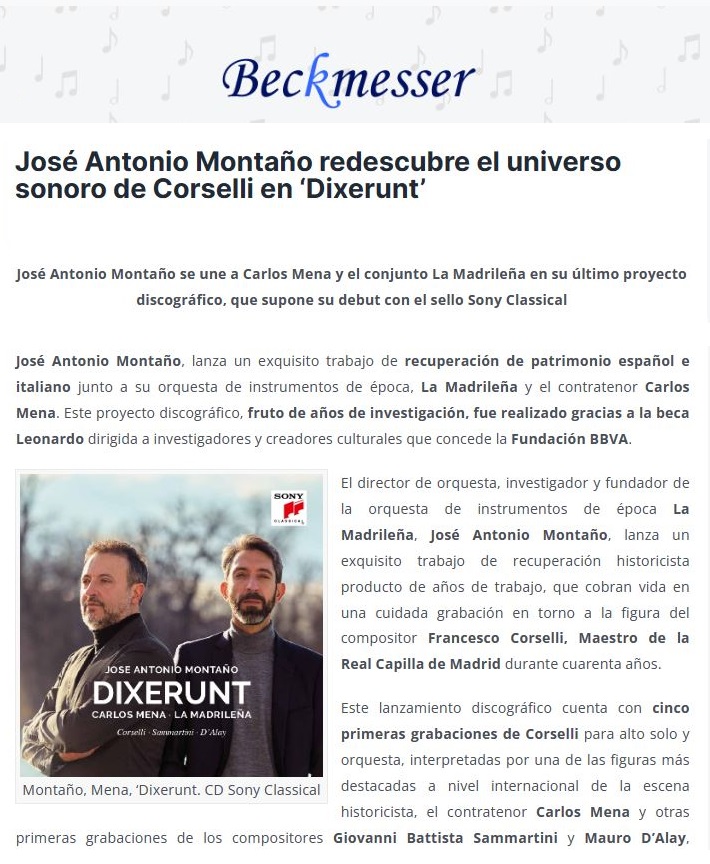 José Antonio Montaño se une a Carlos Mena y el conjunto La Madrileña en su último proyecto discográfico, que supone su debut con el sello Sony Classical.
José Antonio Montaño se une a Carlos Mena y el conjunto La Madrileña en su último proyecto discográfico, que supone su debut con el sello Sony Classical.
José Antonio Montaño, lanza un exquisito trabajo de recuperación de patrimonio español e italiano junto a su orquesta de instrumentos de época, La Madrileña y el contratenor Carlos Mena. Este proyecto discográfico, fruto de años de investigación, fue realizado gracias a la beca Leonardo dirigida a investigadores y creadores culturales que concede la Fundación BBVA.
El director de orquesta, investigador y fundador de la orquesta de instrumentos de época La Madrileña, José Antonio Montaño, lanza un exquisito trabajo de recuperación historicista producto de años de trabajo, que cobran vida en una cuidada grabación en torno a la figura del compositor Francesco Corselli, Maestro de la Real Capilla de Madrid durante cuarenta años.
Este lanzamiento discográfico cuenta con cinco primeras grabaciones de Corselli para alto solo y orquesta, interpretadas por una de las figuras más destacadas a nivel internacional de la escena historicista, el contratenor Carlos Mena y otras primeras grabaciones de los compositores Giovanni Battista Sammartini y Mauro D’Alay, incluidas también en este proyecto.
La grabación fue realizada en enero de 2022 en la Real Academia de Bellas Artes de San Fernando, en Madrid. El repertorio está compuesto por la Sinfonia in Sol Maggiore J-C39 y el Concertino a 4 stromenti in Sol Maggiore de Giovanni Battista Sammartini, Regina Caeli, Ave Regina, el Concertino a 4 en Re mayor, Lamentación 2ª de Miércoles Santo y Lamentación 2ª de Jueves Santo de Francisco Corselli, junto al Responsorio a Santa Cecilia también de Corselli y por último, el Concerto per 2 violini in Re minore de Mauro D’Alay.
José Antonio Montaño trabajó directamente con las fuentes manuscritas encontradas en diversas entidades como el Archivo del Palacio Real de Madrid, la colección Blancheton o la Dresden Sächsische Landesbibliothek (Biblioteca estatal sajona de Dresde) para editar las partituras empleadas en esta grabación.
Para la realización de este trabajo, de enorme interés artístico y musicológico, José Antonio Montaño recibió una de las prestigiosas becas Leonardo de la Fundación BBVA destinada a la recuperación de patrimonio español y europeo, interpretado en una grabación de indiscutible calidad realizada por magníficos músicos españoles de proyección internacional. (Leer artículo completo).
Fundación BBVA – José Antonio Montaño presenta el CD ‘Dixerunt’, con siete primeras grabaciones mundiales de la música que marca la transición del barroco al clasicismo en España.
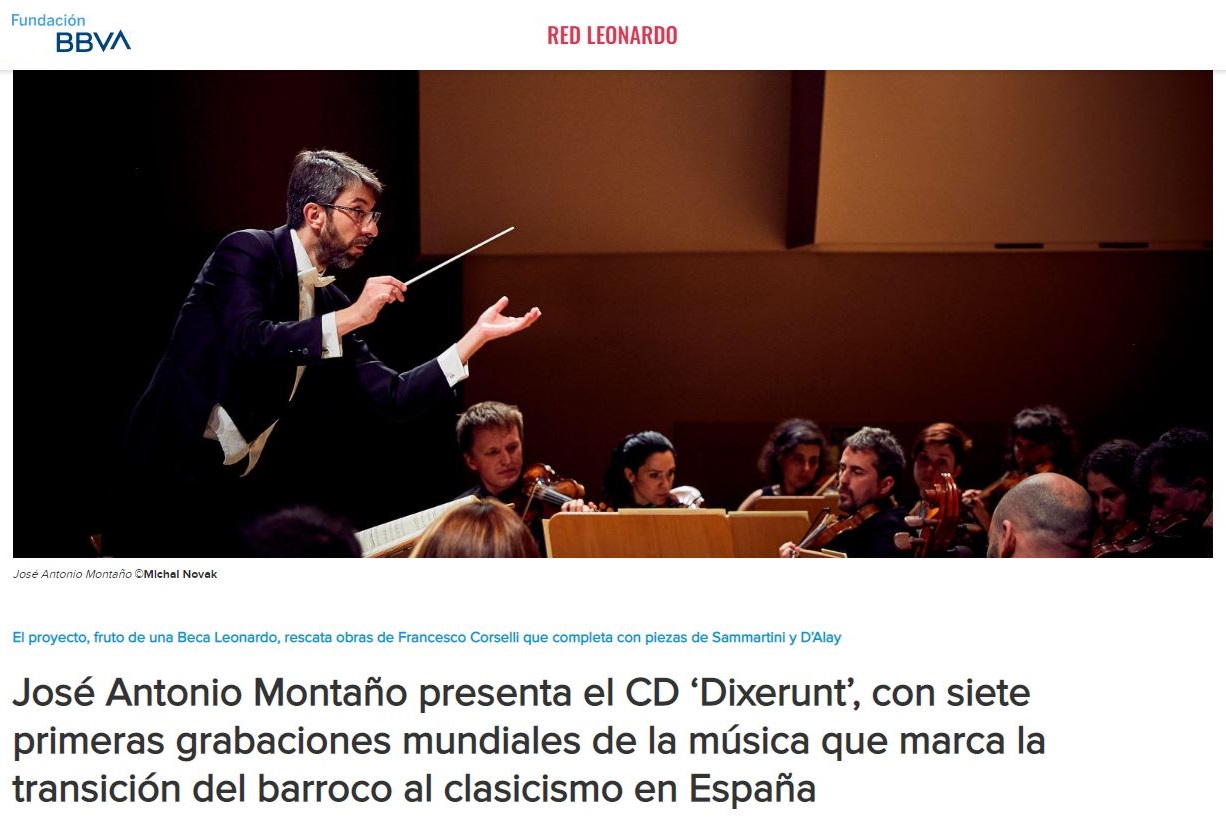 Un arduo trabajo de investigación sostenido por una Beca Leonardo en Música y Ópera ha permitido a José Antonio Montaño recuperar y reunir en un disco –Dixerunt, que Sony Classical acaba de lanzar- seis obras de Francesco Corselli, dos de Giovanni Battista Sammartini y una de Mauro D’Alay compuestas o interpretadas en la etapa central del siglo XVIII en un importantísimo centro musical europeo como era Madrid.
Un arduo trabajo de investigación sostenido por una Beca Leonardo en Música y Ópera ha permitido a José Antonio Montaño recuperar y reunir en un disco –Dixerunt, que Sony Classical acaba de lanzar- seis obras de Francesco Corselli, dos de Giovanni Battista Sammartini y una de Mauro D’Alay compuestas o interpretadas en la etapa central del siglo XVIII en un importantísimo centro musical europeo como era Madrid.
Para entender la importancia de Francesco Corselli (Piacenza, Italia, 1705 – Madrid, España, 1778) hay que considerar que “fue maestro de la Real Capilla de la corte española durante nada menos que cuatro décadas” y que “recibió el encargo de escribir música después del devastador incendio del Alcázar, en el que las llamas devoraron el archivo musical de la corte que allí se custodiaba”, explica Montaño. “Corselli toma la tradición italiana en la que se ha formado -y que era la música de mayor aceptación en todo el continente- y la mezcla con la imponente herencia española del Renacimiento”.
Una de las peculiaridades del proyecto es que la investigación musicológica ha recaído en la misma persona que iba a capitanear la interpretación y grabación de las obras, pues José Antonio Montaño es director de orquesta y en 2016 fundó La Madrileña, orquesta con instrumentos de época con la que ha actuado en espacios tan representativos como el Teatro Real o el Auditorio Nacional de Música. “La ventaja de encargarme de la investigación musicológica y también de la interpretación musical, es que todo el proceso pasa por la misma cabeza desde el primer momento. Cuando emergen dudas o discordancias entre las distintas fuentes con las que se trabaja en el proceso musicológico, mi experiencia como intérprete me ofrece un punto de vista complementario que me ayuda a tomar decisiones más acertadas en un proceso básico como es la edición de una partitura. De esta manera, desde que arranca la investigación comienza también un proceso de toma de decisiones artísticas que se prolonga a lo largo de todo el estudio y que, todo hay que decirlo, dado que incluye numerosas partituras que estudias y luego descartas para conseguir que la selección final del disco sea lo más representativa posible, supone un esfuerzo titánico”. (Leer artículo completo).
Ritmo – José Antonio Montaño redescubre el universo sonoro de Corselli en Dixerunt, su nuevo trabajo discográfico publicado por Sony Classical.
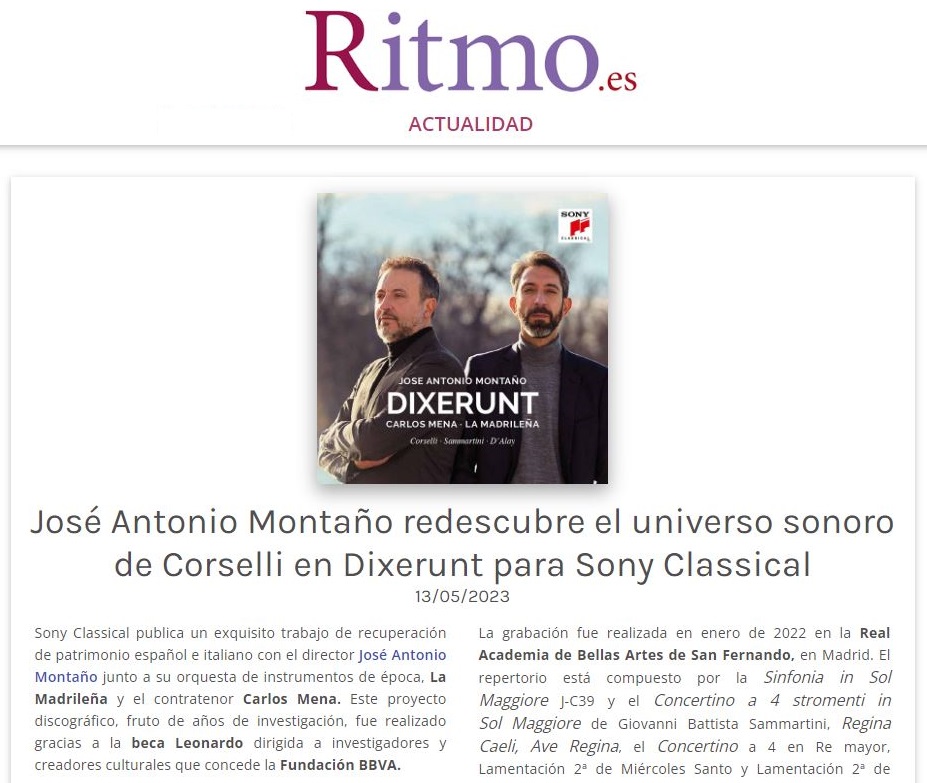 Sony Classical publica un exquisito trabajo de recuperación de patrimonio español e italiano con el director José Antonio Montaño junto a su orquesta de instrumentos de época, La Madrileña y el contratenor Carlos Mena. Este proyecto discográfico, fruto de años de investigación, fue realizado gracias a la beca Leonardo dirigida a investigadores y creadores culturales que concede la Fundación BBVA.
Sony Classical publica un exquisito trabajo de recuperación de patrimonio español e italiano con el director José Antonio Montaño junto a su orquesta de instrumentos de época, La Madrileña y el contratenor Carlos Mena. Este proyecto discográfico, fruto de años de investigación, fue realizado gracias a la beca Leonardo dirigida a investigadores y creadores culturales que concede la Fundación BBVA.
Este trabajo de recuperación historicista, producto de años de trabajo, cobra vida en una cuidada grabación en torno a la figura del compositor Francesco Corselli, Maestro de la Real Capilla de Madrid durante cuarenta años.
Este lanzamiento discográfico cuenta con cinco primeras grabaciones de Corselli para Alto solo y orquesta, interpretadas por una de las figuras más destacadas a nivel internacional de la escena historicista, el contratenor Carlos Mena y otras primeras grabaciones de los compositores Giovanni Battista Sammartini y Mauro D’Alay, incluidas también en este proyecto.
La grabación fue realizada en enero de 2022 en la Real Academia de Bellas Artes de San Fernando, en Madrid. El repertorio está compuesto por la Sinfonia in Sol Maggiore J-C39 y el Concertino a 4 stromenti in Sol Maggiore de Giovanni Battista Sammartini, Regina Caeli, Ave Regina, el Concertino a 4 en Re mayor, Lamentación 2ª de Miércoles Santo y Lamentación 2ª de Jueves Santo de Francisco Corselli, junto al Responsorio a Santa Cecilia también de Corselli y por último, el Concerto per 2 violini in Re minore de Mauro D’Alay.
José Antonio Montaño trabajó directamente con las fuentes manuscritas encontradas en diversas entidades como el Archivo del Palacio Real de Madrid, la colección Blancheton o la Dresden Sächsische Landesbibliothek (Biblioteca estatal sajona de Dresde) para editar las partituras empleadas en esta grabación. (Leer artículo completo).
Ritmo – 13-05-2023
Melómano – José Antonio Montaño redescubre a Corselli.
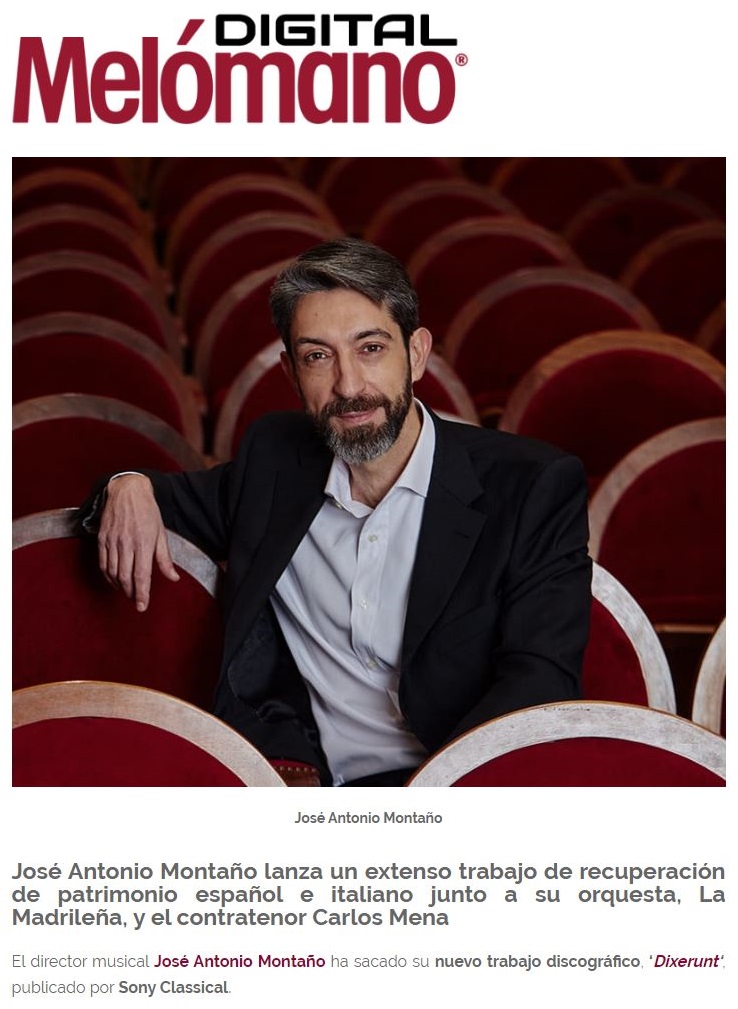 José Antonio Montaño lanza un extenso trabajo de recuperación de patrimonio español e italiano junto a su orquesta, La Madrileña, y el contratenor Carlos Mena.
José Antonio Montaño lanza un extenso trabajo de recuperación de patrimonio español e italiano junto a su orquesta, La Madrileña, y el contratenor Carlos Mena.
El director musical José Antonio Montaño ha sacado su nuevo trabajo discográfico, ‘Dixerunt‘, publicado por Sony Classical.
Junto con su orquesta de instrumentos de época, La Madrileña,y el contratenor Carlos Mena,el proyecto, fruto de años de trabajo, cobra vida en una cuidada grabación en torno a la figura del compositor Francesco Corselli, maestro de la Real Capilla de Madrid durante cuarenta años.
Para la realización de este trabajo, Montaño recibió una de las prestigiosas Becas Leonardo de la Fundación BBVA destinada a la recuperación de patrimonio español y europeo. La grabación fue realizada en enero de 2022 en la Real Academia de Bellas Artes de San Fernando, en Madrid.
El álbum
Este lanzamiento discográfico cuenta con cinco primeras grabaciones de Corselli para alto solo y orquesta, interpretadas por el contratenor Carlos Mena. También incluye otras primeras grabaciones de los compositores Giovanni Battista Sammartini y Mauro D’Alay.
El repertorio está compuesto por la Sinfonia in Sol Maggiore JC39 y el Concertino a 4 stromentiin SolMaggiorede Giovanni Battista Sammartini. El Concerto per 2 violini in Re minore de Mauro D’Alay. Y de Francisco Corselli se incluyen: Regina Caeli, Ave Regina, el Concertino a 4 en Re mayor, dos lamentaciones de Miércoles y Jueves Santo, así como el Responsorio a Santa Cecilia.
José Antonio Montaño trabajó directamente con las fuentes manuscritas encontradas en diversas entidades como el Archivo del Palacio Real de Madrid,la Colección Blancheton o la Dresden SächsischeLandesbibliothek (Biblioteca Estatal Sajona de Dresde) para editar las partituras empleadas en esta grabación. (Leer artículo completo).
Revista Melómano – 15-05-2023
Docenotas – José Antonio Montaño redescubre el universo sonoro de Corselli en Dixerunt, su nuevo trabajo discográfico publicado por Sony Classical.
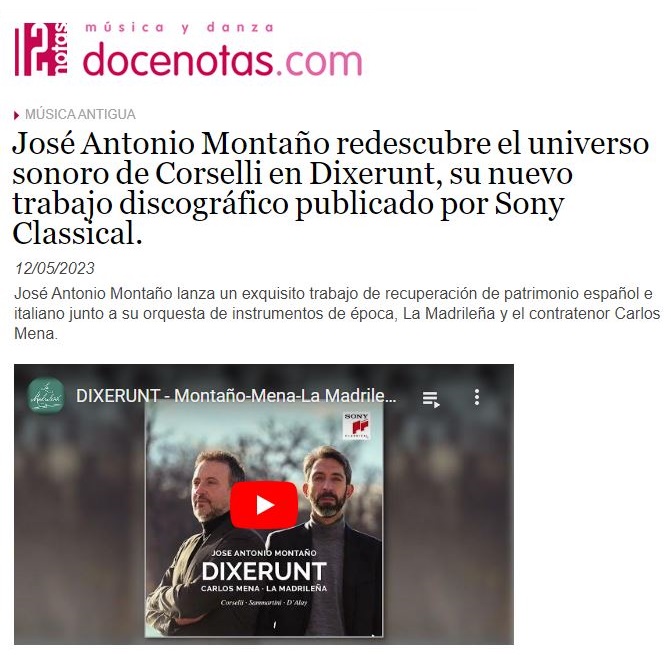 José Antonio Montaño lanza un exquisito trabajo de recuperación de patrimonio español e italiano junto a su orquesta de instrumentos de época, La Madrileña y el contratenor Carlos Mena.
José Antonio Montaño lanza un exquisito trabajo de recuperación de patrimonio español e italiano junto a su orquesta de instrumentos de época, La Madrileña y el contratenor Carlos Mena.
Este proyecto discográfico, fruto de años de investigación, fue realizado gracias a la beca Leonardo dirigida a investigadores y creadores culturales que concede la Fundación BBVA.
Este lanzamiento discográfico cuenta con cinco primeras grabaciones de Corselli para Alto solo y orquesta, interpretadas por una de las figuras más destacadas a nivel internacional de la escena historicista, el contratenor Carlos Mena y otras primeras grabaciones de los compositores Giovanni Battista Sammartini y Mauro D’Alay, incluidas también en este proyecto.
La grabación fue realizada en enero de 2022 en la Real Academia de Bellas Artes de San Fernando, en Madrid. El repertorio está compuesto por la Sinfonia in Sol Maggiore J-C39 y el Concertino a 4 stromenti in Sol Maggiore de Giovanni Battista Sammartini, Regina Caeli, Ave Regina, el Concertino a 4 en Re mayor, Lamentación 2ª de Miércoles Santo y Lamentación 2ª de Jueves Santo de Francisco Corselli, junto al Responsorio a Santa Cecilia también de Corselli y por último, el Concerto per 2 violini in Re minore de Mauro D’Alay.
José Antonio Montaño trabajó directamente con las fuentes manuscritas encontradas en diversas entidades como el Archivo del Palacio Real de Madrid, la colección Blancheton o la Dresden Sächsische Landesbibliothek (Biblioteca estatal sajona de Dresde) para editar las partituras empleadas en esta grabación.
Para la realización de este trabajo, “de enorme interés artístico y musicológico”, José Antonio Montaño recibió una de las prestigiosas becas Leonardo de la Fundación BBVA destinada a la recuperación de patrimonio español y europeo, interpretado en una grabación de indiscutible calidad realizada por magníficos músicos españoles de proyección internacional. (Leer artículo completo).
Docenotas – 12 marzo 2023
Revista Scherzo – José Antonio Montaño grabará cantatas inéditas de Corselli gracias a una Beca Leonardo.
 El director de orquesta José Antonio Montaño ha sido seleccionado por la Fundación BBVA como beneficiario de la Beca Leonardo a Investigadores y Creadores Culturales en el área de Música y Ópera, de acuerdo al informe de la comisión evaluadora, integrada por expertos de reconocido prestigio como el director artístico del Teatro Real, Joan Matabosch, el director artístico del Gran Teatre del Liceu, Víctor García de Gomar, o el compositor Tomás Marco.
El director de orquesta José Antonio Montaño ha sido seleccionado por la Fundación BBVA como beneficiario de la Beca Leonardo a Investigadores y Creadores Culturales en el área de Música y Ópera, de acuerdo al informe de la comisión evaluadora, integrada por expertos de reconocido prestigio como el director artístico del Teatro Real, Joan Matabosch, el director artístico del Gran Teatre del Liceu, Víctor García de Gomar, o el compositor Tomás Marco.
El proyecto de Montaño afrontará la primera grabación de obras sacras en latín para alto solo del maestro de la Real Capilla de Madrid Francisco Corselli y será efectuada con La Madrileña (su orquesta de instrumentos de época) y con el contratenor Carlos Mena.
Montaño forma parte del equipo de investigación del Proyecto Didone del Instituto Complutense de Ciencias Musicales de la Universidad Complutense de Madrid financiado por el Consejo Europeo de Investigaciones. Desde hace años compagina su carrera internacional como director de orquesta con diversos proyectos de investigación y recuperación de patrimonio musical español del siglo XVIII. Entre ellos destaca la edición y grabación en primicia del Requiem de José de Nebra al frente de La Madrileña, el Coro Victoria y Schola Antiqua (Pan Classics 2019). Este nuevo trabajo con las obras de Corselli supondrá un importante paso en su apuesta por la divulgación de la música española y consolida a Montaño como uno de los investigadores e intérpretes más destacados del panorama nacional. (Leer artículo completo).
Revista Scherzo – 14 junio 2021
Revista Melómano – José Antonio Montaño, ganador de la beca Leonardo 2021.
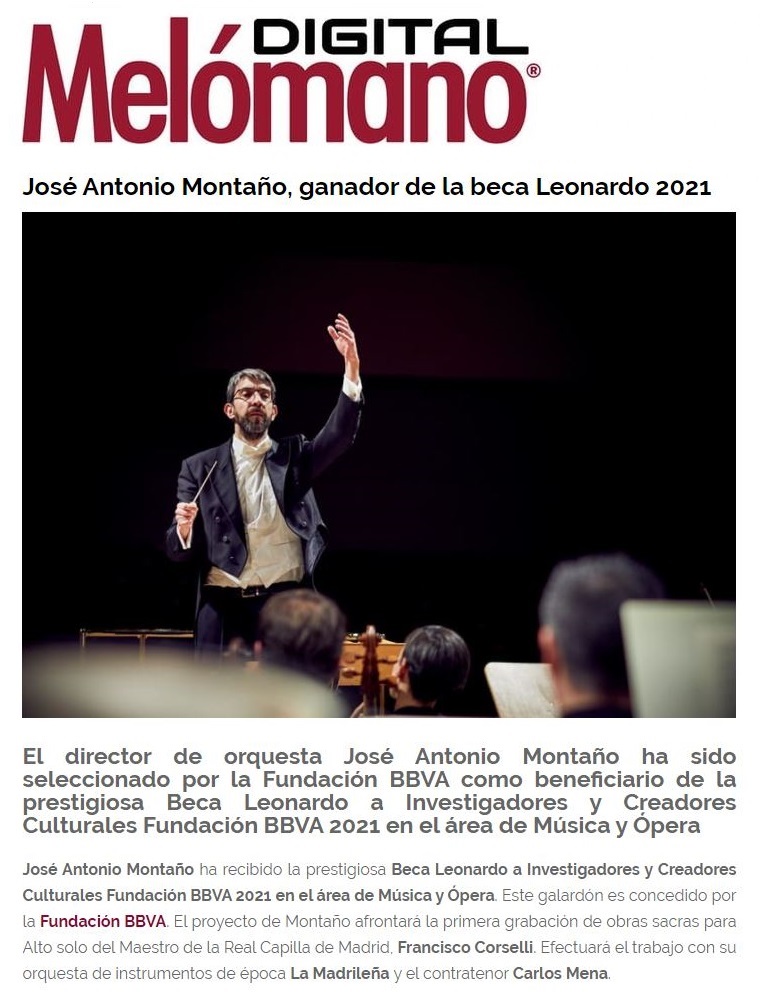 El director de orquesta José Antonio Montaño ha sido seleccionado por la Fundación BBVA como beneficiario de la prestigiosa Beca Leonardo a Investigadores y Creadores Culturales Fundación BBVA 2021 en el área de Música y Ópera.
El director de orquesta José Antonio Montaño ha sido seleccionado por la Fundación BBVA como beneficiario de la prestigiosa Beca Leonardo a Investigadores y Creadores Culturales Fundación BBVA 2021 en el área de Música y Ópera.
José Antonio Montaño ha recibido la prestigiosa Beca Leonardo a Investigadores y Creadores Culturales Fundación BBVA 2021 en el área de Música y Ópera. Este galardón es concedido por la Fundación BBVA. El proyecto de Montaño afrontará la primera grabación de obras sacras para Alto solo del Maestro de la Real Capilla de Madrid, Francisco Corselli. Efectuará el trabajo con su orquesta de instrumentos de época La Madrileña y el contratenor Carlos Mena.
Expertos de reconocido prestigio han integrado la comisión evaluadora. Han sido el director artístico del Teatro Real, Joan Matabosch, y el del Gran Teatre del Liceu, Víctor García de Gomar. También les ha acompañado el compositor Tomás Marco.
José Antonio Montaño
Asimismo, Montaño forma parte del equipo de investigación del Proyecto Didone del Instituto Complutense de Ciencias Musicales de la Universidad Complutense de Madrid. Dicho proyecto cuenta con la financiación del Consejo Europeo de Investigaciones. El director, desde hace años, compagina su carrera internacional como director de orquesta con diversos proyectos de recuperación de patrimonio musical español del siglo XVIII.
Entre ellos destaca la edición y grabación en primicia del Requiem de José de Nebra al frente de su orquesta La Madrileña. Además, estuvieron en colaboración con el Coro Victoria y Schola Antiqua. Este nuevo trabajo con las obras de Corselli supondrá un importante paso en su apuesta por la divulgación de la música española. Además, consolidará a Montaño como uno de los investigadores e intérpretes más destacados del panorama nacional. (Leer artículo completo).
Revista Melómano – 11 junio 2021
DIXERUNT
Lamentación segunda de Miércoles Santo
Vau.
Et egressus est a filia Sion omnis decor ejus;
facti sunt principes ejus velut arietes non invenientes pascua,
et abierunt absque fortitudine ante faciem subsequentis.
Zain.
Recordata est Jerusalem
dierum afflictionis suae et praevaricationis,
omnium desiderabilium suorum,
quae habuerat a diebus antiquis,
cum caderet populus ejus in manu hostili, et non esset auxiliator;
viderunt eam hostes
et deriserunt sabbata ejus.
Heth.
Peccatum peccavit Jerusalem,
propterea instabilis facta est;
omnes, qui glorificabant eam,
spreverunt illam,
quia viderunt ignominiam ejus:
ipsa autem gemens
conversa est retrorsum.
Teth.
Sordes ejus in pedibus ejus,
nec recordata est finis sui;
deposita est vehementer,
non habens consolatorem.
Vide, Domine, afflictionem meam,
quoniam erectus est inimicus.
Jerusalem, Jerusalem, convertere ad Dominum, Deum tuum.
Vau.
La hija de Sión ha perdido todo su esplendor;
sus príncipes son como carneros que no encuentran pastos,
van caminando sin fuerzas delante del que los persigue.
Zain.
Jerusalén recuerda sus días de aflicción
y prevaricación, y todos sus bienes, que
había tenido desde los días antiguos,
cuando su pueblo sucumbía a manos
enemigas sin que nadie viniera en su
ayuda; sus enemigos la miraban y se
burlaban de sus días sagrados.
Heth.
Mucho ha pecado Jerusalén,
y por eso se ha hecho inestable;
todos los que la honraban
la desprecian,
pues han visto su deshonra,
y ella misma gime y se
vuelve de espaldas.
Teth.
La inmundicia está en sus pies,
no pensaba ella en este fin;
está completamente hundida,
y no tiene quien la consuele.
Mira, Señor, mi aflicción,
porque el enemigo triunfa.
Jerusalén, Jerusalén, conviértete a tu Dios y Señor.
Regina Caeli
Regina caeli, laetare. Alleluia.
Quia quem meruisti portare, Alleluia,
Resurrexit, sicut dixit. Alleluia.
Ora pro nobis Deum. Alleluia.
Reina del cielo, alégrate. Aleluya.
Porque el que mereciste llevar en tu seno, Aleluya,
Ha resucitado, según predijo. Aleluya.
Ruega a Dios por nosotros. Aleluya.
Lamentación segunda de Jueves Santo
Lamed.
Matribus suis dixerunt:
Ubi est triticum et vinum?
Cum deficerent quasi vulnerati
in plateis civitatis,
cum exhalarent animas suas in sinu matrum suarum.
Mem.
Cui comparabo te?
vel cui assimilabo te,
filia Jerusalem?
Cui exaequabo te,
et consolabor te,
Virgo, filia Sion?
Magna est enim velut mare
contritio tua; quis medebitur tui?
Nun.
Prophetae tui viderunt tibi falsa et
stulta, nec aperiebant iniquitatem tuam,
ut te ad paenitentiam provocarent;
viderunt autem tibi assumptiones falsas
et ejectiones.
Samech.
Plauserunt super te manibus omnes
transeuntes per viam; sibilaverunt et
moverunt caput suum super filiam Jerusalem,
Haecine est urbs, dicentes, perfecti
decoris gaudium universae terrae?
Jerusalem, Jerusalem, convertere ad Dominum Deum.
Lámed
Dijeron a sus madres:
“¿Dónde hay trigo y vino?”,
mientras desfallecían como heridos
en las plazas de la ciudad,
y exhalaban su alma en el regazo de sus madres.
Mem
¿A quién te compararé,
o a quién te asemejaré,
hija de Jerusalén?
¿A quién te igualaré
para consolarte,
virgen hija de Sión?
Pues grande como el mar es tu
tribulación: ¿Quién te sanará?
Nun
Tus profetas te vaticinaron cosas falsas
y necias, y no desvelaban tu iniquidad
ni te movían a penitencia,
sino que te vaticinaron conquistas
y victorias falsas.
Sámek
Todos los que pasaban por el camino
se burlaban de ti con aplausos, silbaban
y movían la cabeza contra la hija de Jerusalén,
diciendo: ¿Esta es la ciudad de la
perfecta belleza, el gozo del universo?
Jerusalén, Jerusalén, conviértete al Señor tu Dios.
Ave Regina
Ave Regina caelorum,
ave Domina Angelorum.
Salve radix, salve porta
ex qua mundo lux est orta.
Gaude, Virgo gloriosa,
super omnes speciosa.
Vale, o valde decora,
et pro nobis Christum exora.
Ave, Reina de los cielos,
ave, Señora de los ángeles.
Salve, raíz, salve, puerta
de la que nació la luz para el mundo.
Alégrate, Virgen gloriosa,
entre todas la más hermosa.
Salve, oh muy bella,
y ruega a Cristo por nosotros.
Traducciones, Emilio Gª Ruiz
